(Click on thewilliam name to s ee the bio and the work description below)
Andreas Blank
Jonas Burgert
Tony Cragg
Wojtek Doroszuk
Nezaket Ekici
FRANEK
Asta Gröting
Sven Helbig
Stefan Höller
Olaf Holzapfel
Huang Jia
Nikita Kadan
William Kentridge
Ola Kolehmainen
Via Lewandowsky
Bernd Lohaus
Sarah Loibl
Boris Mikhailov
Fiona Pardington
Angelika Platen
Gerhard Richter
Stefan Rinck
Arsen Savadov
Katharina Sieverding
Vadim Zakharov
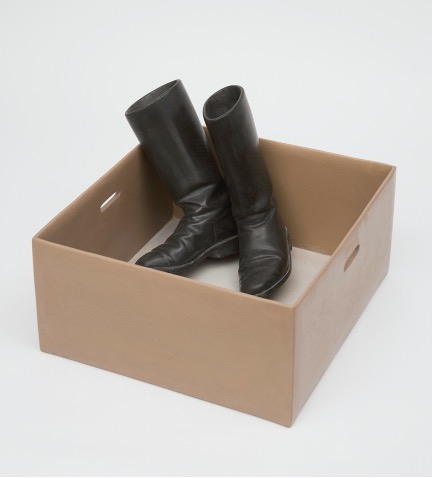
Box with military boots
2010, Limestone, Serpentinite, 56 x 55 x 38,5 cm
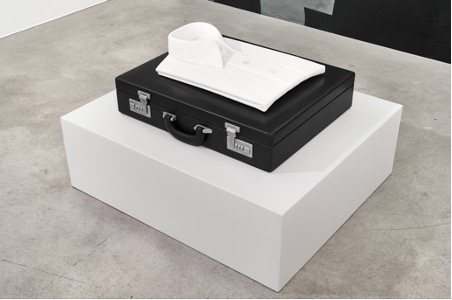
Monument
2021, Marble, Basalt, Alabaster, Serpentinite, Bronze, 124 x 107 x 70 cm
|
POINTS of RESISTANCE IV: Skills for Peace presents three of Andreas Blank’s iconic works – a businessman’s white shirt carefully folded atop his briefcase, and military boots standing upright in their box, ready to wear. The juxtaposition of these two works is sadly emblematic of our times. With the Russian invasion of Ukraine, war has tragically returned to Europe. In many Ukrainian cities, people are working from home or from bomb shelters, while offices are allocated to the streams of refugees fleeing from homes turned into battlegrounds. Those conscripted into the war on both sides, forced to fight for expansion or required to stay and defend their homeland, have replaced their business attire with combat boots, and their briefcases with guns. And with so many lost lives being mourned in Ukraine, Blank’s basalt shroud hanging on the wall is reminiscent of the mirrors draped over in black in the houses of the dead. “To a certain extent, the work has an archaeological character: the contemporary world, here: German history, becomes petrified, it acquires timelessness. In this case, a real pair of leather military boots, with which Andreas Blank’s grandfather returned from the war and from captivity, was the template – the boots were stored in a box under the roof for decades. The box was then set in stone to form the inverted base. The pedestal is also a time depot at the same time. It is a real anti-war piece.” – Stephan von Wiese
In his sculptural practice, Andreas Blank combines the abstract and the realistic, the conceptual as well as the technical. He sources stones from quarries from all over the world, carves them with elaborate deliberation, and assembles them as deceptively realistic objects of the everyday. In his precise installations, the apparently ephemeral objects achieve monumental permanence. Whether marble, alabaster, or porphyry, material historically used to serve religious or political functions, has in Blank’s hands acquired a seemingly casual and fragmentary character. The geographical and cultural identity of the stone and the memorial function of stone-sculpture in general refer to the value of each object. Blank questions the obvious and transforms traditional ideals, subverting the value of the ordinary and mundane. In a discourse of image and likeness, things lose their functional purpose, transcending into pure, formalistic objects. Stone sculptures, which historically were intended primarily for political representation or religious devotion, in Andreas Blank’s works come to question a (post)modernist nihilism. His works succeed to condense time and narrative structures, stretching the limits of traditional sculpture.
|
Andreas Blank (born in Ansbach in 1976) is a Berlin-based sculptor. He attended the Karlsruhe State Academy of Art (Staatliche Akademie der Bildenden Künste) and was a student of Prof. Harald Klingelhöller. He held a scholarship with the German National Academic Foundation and received his Master of Fine Art from the Royal College of Art in London. In 2009 he was a finalist for the New Sensations Award by Channel 4 and the Saatchi Gallery. Among other venues, he has exhibited at Choi&Lager Galerie Köln (2021), Galerie Knecht und Burster, Karlsruhe (2019), Bernheimer Contemporary, Berlin (2016), Royal College of Art, London (2009). |

Licht lügt / Light lies
2014, Oil on Canvas, 240 x 220 cm
|
In the mystical, theatrical paintings of Jonas Burgert, the figures move in front of a membrane of cultural symbols and archaic patterns that seem to come down to us from another dimension. Jonas Burgert personifies human psychology through figurative painting bordering on the grotesque. Astutely observing the minutiae of daily life, he bears witness to the entire range of human emotion. Loneliness, hatred, revenge, vanity and excess – a parade of human expressions feeds his imagination – giving form to the characters within his tableaux. There is a timeless sense of other dimensions and emotional undercurrents reflected in the ruptured layers of Burgert’s environments. Often breached by characters and architectural features, these tears in the pictorial plane reveal various levels existing simultaneously. Burgert’s canvasses abound with rubble, detritus, remnants of history, cinders of the art of painting – the very cinders that serve to feed greed. However, they are of a fleeting nature. Their purpose is to devour the images and to unleash from the chaos the impulse and those emotions that linger in the memory.
|
Jonas Burgert (born in Berlin in 1959) is a Berlin based contemporary artist. He has shown work in many exhibitions including Rohkunstbau at Stipendiaten in Berlin, Geschichtenerzähler at Hamburg Kunsthalle and Dis-Positiv at Staatsbank in Berlin. Burgert has exhibited internationally at museums and galleries such as Galerie Sfeir-Semler, Beirut and Villa Manin, Passariano, Italy and was part of the Malerei Biennale in Stockholm in 2003. He is represented by Produzentengalerie in Hamburg BlainSouthern in London and Tang Contemporary Art in Hong Kong. He has also exhibited in Seattle, Mumbai, London and Denver. From January to April 2017 he exhibited his first solo show “Lotsucht. Scandagliodipendenza in Italy, at MAMbo in Bologna. |

Karst
2020, Bronze Sculpture: 125 (h) x 136 x 96 cm, Pedestal: 40 (h) x 60 x 90 cm, Weight 500 kg
Courtesy of André Buchman, Buchmann Galerie
|
Collecting, sorting, stacking, and layering material is a working process that Tony Cragg has repeatedly tested as a sculptural principle since the 1970s. The bronze Karst impressively demonstrates the progress of this principle. The sculpture is reminiscent of geological formations and seems to push against gravity with powerful force. Tony Cragg stands out as one of the foremost sculptors of our time. His oeuvre testifies to a method of working in which he constantly negotiates with questions of the figural by revisiting and further developing sculptural solutions to representation. Duplication, nesting, and scaling are methods that Tony Cragg masterfully combines in ever-new ways. His work’s continuity and validity relate to the fundamental questions about the relationship between body, matter, object, and space, which the artist has been dealing with continuously for decades. “In order to decide about the form and structure of many things we will need sculpture and sculptural thinking. I would like to apply sculptural thinking to biomechanics, to government institutions, to social structure etc.” – Tony Cragg, 2006
|
Tony Cragg (born in Liverpool in 1949) has lived and worked in Wuppertal, Germany since 1977. He has a BA from Wimbledon School of Art, London, UK (1973) and an MA from the Royal College of Art, London, UK (1977). Among many major solo shows he has exhibited at Houghton Hall, UK (2021); Museum Belvédere, Netherlands (2021); Museu Oscar Niemeyer, Brazil (2020); Split Kula Cultural Institution, Croatia (2019); City of Arts and Sciences, Spain (2018); Isfahan Museum of Contemporary Art, Iran (2018); Istanbul Modern, Turkey (2017); Yorkshire Sculpture Park, UK (2017); the National Museum of Havana, Cuba (2017); MUDAM Luxembourg, Luxembourg (2017); Ludwig Museum, Koblenz, Germany (2017); Wroclaw Contemporary Art Museum, Wroclaw, Poland (2017); The State Hermitage Museum, St Petersburg, Russia (2016; Benaki Museum, Athens, Greece (2015); Gothenburg International Sculpture Exhibition, Gothenburg, Sweden (2015); Heydar Aliyev Centre, Baku, Azerbaijan (2014); National Taiwan Museum of Fine Arts, Taichung, Taiwan (2013); CAFA Museum in Beijing, China (2012); Musée du Louvre, Paris, France (2011); the Scottish National Gallery, Edinburgh, UK (2011); Nasher Sculpture Center, Dallas, TX, USA (2011); Skulpturenpark Waldfrieden, Wuppertal, Germany (2010); Tate Gallery, Liverpool, UK (2000); Museo Nacional Centro de Arte, Reina Sofia, Madrid, Spain (1995), Stedelijk van Abbemuseum, Eindhoven, The Netherlands (1991) and Tate Gallery, London, UK (1988). He represented Britain at the 43rd Venice Biennale in 1988 and in the same year was awarded the Turner Prize at the Tate Gallery, London, UK. He has been a Professor at Ecole Nationale Supérieure des Beaux Arts, Paris, France (1999-2009) and Professor at Kunstakademie, Düsseldorf, Germany (2009–present). He was elected a Royal Academician in 1994; received the Praemium Imperiale for Sculpture, Tokyo, Japan (2007); was Awarded the 1st Class Order of Merit of the Federal Republic of Germany (2012) and was made a Knight’s Bachelor in 2016. |
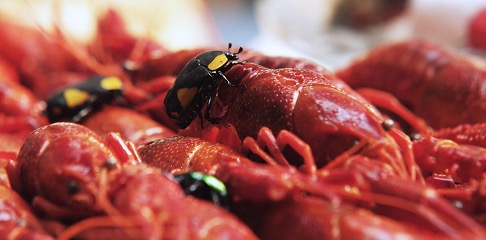
Festin
2013, HD Video, 20′ 15″, Ed. 5/8+1
|
Festin takes as its inspiration the paintings of the 17th century Flemish still life artists, such as Frans Snyder, Jan and Ferdinand Van Kessel who depicted sumptuous spreads of food, often garnished with dead animals which have been recently shot. Further alluding to Peter Greenaway’s scenes of sumptuous decay, Festin envisages a feast interrupted by an unknown calamity, a world from which human beings have disappeared. The film portrays a timeless vanitas tableau of decay and disorder where non-existent guests have been usurped by the uninvited intrusion of insects and stray dogs. This imagery creates a post-apocalyptic epilogue for humankind, a portent of what may result if human greed continues to grow unabated. Seeing this work in the context of the war in Ukraine, one cannot help but imagine a last supper left to rot, the guests fleeing to join the streams of refugees displaced by battles on city streets, closer to home than any of us could have imagined mere months ago. The ubiquity of war, even today in our seemingly enlightened age, renders this contemporary vanitas that much more timeless.
|
Wojtek Doroszuk (born 1980, Poland) is a visual artist. He works with video and photography. He is interested in society as a spectacle and a series of conventions which he tries to deconstruct. He asks why we so easily reconcile ourselves to the existing, what is repressed, and invokes the stranger. In his Istanbul project, consisting of a series of aestheticized postcards with non-standard views, hidden from tourists, and information like this on the back, and the film triptych Picnic, Lunch I and Lunch II (2005), he shows the impossibility of communication, translation of behavior and cultural habits. It draws attention to colonial conditioning and orientalist perceptions, which are visible even despite the political correctness of conscious Europeans. Similar themes recur in Free Cracow Tour (2005), a mystified walk around Krakow for foreigners, a work she created with Anna Szwajgier, or Video Party (2006), a party at which foreign students staying in Poland play alleged games typical of Poles. He has exhibited at Kunsthalle Bratislava, Slovakia (2019), Maksla XO Gallery, Vilnius, Lithuania (2018), Arsenal Gallery, Białystok, Poland (2016), Galerie Joseph Tang, Paris (2013), EKKM, Tallin (2011), lokal_30, Warsaw, Poland (2010), Platan Gallery, Budapest, Hungary (2010), Main Train Station of Ankara, Turkey (2007), Sala Verónicas, Centro Párraga, Murcia, Spain (2007), Container Gallery, Roma, Italy (2006). He lives and works in Kraków. |
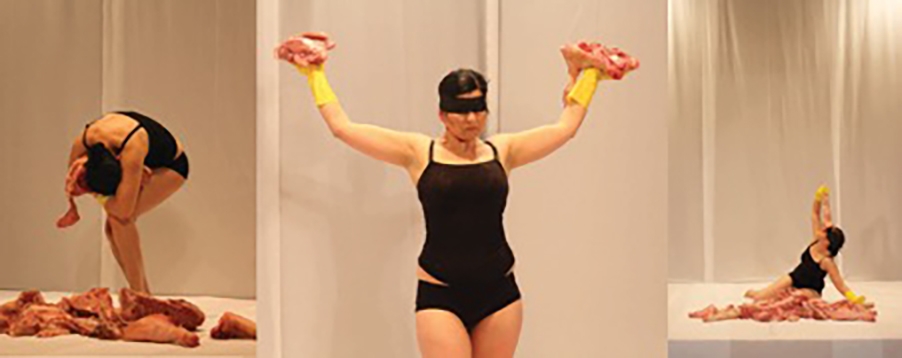
Flesh (No Pig but Pork)
2011, Performance Video, HD, sound, 9’34”
|
The artist kneels in a pile of pork from a freshly slaughtered pig. She wears safety goggles and rubber gloves which refer to the Islamic law forbidding the touching and eating of pork. She holds up pieces of meat and sniffs at them as if to ascertain why the law exists. The sound of her breathing is amplified by a microphone and is clearly audible throughout the room. The work is a direct reference to her piece No Pork but Pig (2004) in which she spent several hours in a small pen with a living pig. Throughout Ekici’s performance practice, she again and again confronts the image of a woman and an artist caught between cultures. Born not far from Ankara, socialised within the narrow circle of her Turkish family in Germany, she explores the limits of what is physically possible in her projects, radically committing her own body to her artworks. In Flesh, (No Pig but Pork), she targets the taboos and traditional rituals of the Islamic world, donning Lady Justice‘s blindfold, a black leotard and yellow rubber gloves to wallow in pork meat, sniffing the forbidden raw flesh. Presented here in POINTS of RESISTANCE: Skills for Peace, at a time when war has inconceivably broken out in Europe once more, this work transforms from grotesque to tragic. In the face of bombs falling on residential streets, we could all be piles of flesh, meat torn asunder by violence. Lady Justice could well be asking, what could possibly justify that?
|
Nezaket Ekici (born in Kirsehir, Turkey in 1970) is an international performance artist. She holds an M.A. in Art Pedagogy, and studied Art History and Sculpture at the Ludwig-Maximilians-University and Fine Arts Academy Munich (1994-2000). From 2001 to 2004 she studied Performance Art under Marina Abramović at the Hochschule der Bildenden Künste Braunschweig. She received a degree in Fine Arts as well as an MFA degree. Ekici has been presenting her work in national and international exhibitions since 2000: Museum Haus der Kunst in Munich; The Irish Museum of Modern art in Dublin; 25. May Museum Belgrade; PAC Milano; Venice Biennale; P.S.1 New York; Van Gogh Museum Amsterdam; Reina Sophia Museum, Madrid; Museum of Contemporary Art, Istanbul; The Museum of Contemporary Art Taipei/ Taiwan; Poznan Biennale; Curitiba Biennale; Tel Aviv Museum of Art; Istanbul Modern; Marta Herford; Minsheng Art Museum Shanghai; Haus am Waldsee Berlin; KunstWerke Berlin; Oslo Museum; The Contemporary Art Gallery of Georgia, Georgia National Museum, Tbilisi; Museum of Contemporary Art in Krakow, Total Museum Seoul. In 2013/2014, she was an artist in Residency at the Cultural Academy Tarabya in Istanbul and in 2016/2017, she got the Rome Prize and was an artist in Residency at the German Academy Villa Massimo in Rome. In 2018 she received the Paula Modersohn-Becker Art Award, and In 2020 she was an artist in residency at the International Studio & Curatorial Program (ISCP) in Brooklyn, New York, sponsored by the International Senate Department for Culture and Europe, Berlin. Ekici’s work includes mainly performance, video and installation. She presented more than 250 different performances in over 60 countries, more than 170 cities on 4 continents. She lives and works in Berlin, Stuttgart and Istanbul. |
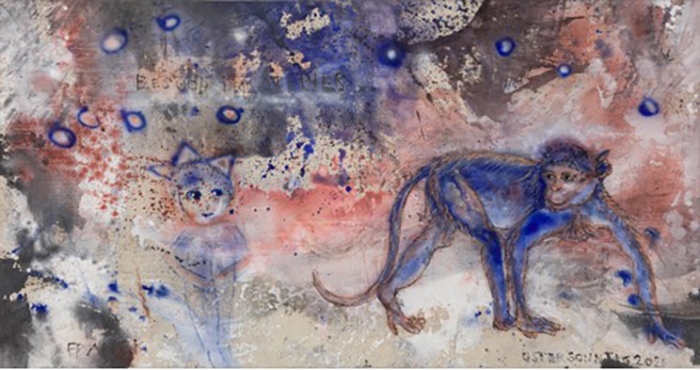
Besuch im Atelier (Ostersonntag) / Visit to the Studio (Easter Sunday)
2021, Mixed media on canvas, 100 x 190 cm
|
My paintings are narrative associative fields – while I work, phantasms surprise me, which then melds with current affairs and pertaining to literature, film and theatre. Through various artistic techniques, available image material and fictional images, I transform these fields into a vast network, which is always in accordance with world events. What’s fascinating is exactly that one doesn’t understand. I play with incomprehension and not with a given history. – FRANEK
|
FRANEK (Sabine Franek-Koch, born in Potsdam in 1939) studied painting and printmaking at the Berlin Art School (now Berlin University of the Arts) with Fred Thieler and Mac Zimmermann. Her first solo exhibition was in 1968 at the Pels-Leusden Gallery in West Berlin. Others followed in galleries, art clubs and museums at home and abroad. She taught at the Berlin Art School, the University of Art and Design in Helsinki and Lahti, and University of the Arts Bremen. FRANEK’s work includes paintings, drawings, prints, book illustration, sculpture, photography and film. In the 1970s and 1980s, the artist became deeply immersed in researching visual symbols used by the indigenous cultures of North and South America. She worked in Mexico, Guatemala and Honduras and helped mathematician Maria Reiche to map spirals (Nazca Lines) on the Nazca Plains in Peru. Furthermore FRANEK recorded rituals for the Übersee-Museum in Bremen among the Lakota (Sioux) at the Rosebud Indian Reservation in the United States. The artist lives and works in Berlin and in Radegast, Lower Saxony. |

Fassade
2019, Installation in wax, 85 x 70 x 5 cm
|
I am working on the assumption that our psychical mechanism has come into being by a process of stratification: the material present in the form of memory traces being subject from time to time to a re-arrangement in accordance with fresh circumstances – to a re-transcription. Thus what is essentially new about my theory is the thesis that memory is present not once but several times over. – Sigmund Freud Letter to Wilhelm Fliess, December 6 1896
Moving on from her long association with ventriloquism in which the hollow doll became an instrument to explore the awkward, perhaps shameful feelings we cannot easily voice to each other, Gröting now gives her attention to the inner voice of the holes, scars and histories transcribed on the architectural surfaces of buildings in her city. How do these memory traces speak to us and how do we speak to them? It is certain that my conversation will be very different from your conversation. The uncanny installations that make up BERLIN FACADES resemble a sculptural, slow- exposure photograph, pushing through the 20th century into the 21st in one simultaneous moment. Where were we then; where are we now? In a bold conceptual strike, Gröting embodies /embalms both trauma and time in a ghostly silicone skin. It is a forensic procedure. Peeling off these memory traces resembles the taking of fingerprints after a crime has been committed. My eyes stare in to the bullet and canon holes and the holes stare right back in to my own psychic holes. In Gröting’s words: “I want to look from inside these destroyed walls and facades into the world – as if I could see my own face staring back at me.” Gröting’s ongoing sculptural conversation between interiors and exteriors across a number of media, her absolute preoccupation with the ways in which the invisible can technically be rendered visible – (a task usually pursued by poets) – makes her uniquely placed to land inside these cracked, pierced, damaged walls. As I stand before these facades, re-transcribed by Gröting in silicone, how am I being invited to read their expression and repression? I am reminded that the function of skin is to protect my body from damage. Furthermore, if skin can access my mood and physical state, it can also bring to the surface any number of turbulent emotions –the historical and personal represented in visible marks and traces. This is why most of us give a great deal of attention to concealing our own facades. Let me tell you that every time I type the word- facade – (also meaning a deceptive outward appearance), my spell- check changes this word to face – a blunt, literal robo -correction, but it is not incorrect. A facade is the face of a building. There is in English the phrase to be stony faced (literally, to have the face of a stone) – meaning to reveal nothing of our inner thoughts, to show no emotion. Yet, as we know, our facades do eventually crumble, and when that happens, we are unmasked to reveal our concealed histories. To return to Freud’s archeological metaphor, in which with great care and patience, the buried “objects” of the past are gradually uncovered and brought to the surface, it would seem that Gröting, in re-transcribing these historical and architectural memory traces (blurring, smudging, smearing still intact) has excavated both past and present, conserving and reconstructing our relations to them. – Deborah Levy, 2016
|
Asta Gröting (born in Herford, Germany, in 1961) is a contemporary artist. She works in a variety of media like sculpture, performance, and video. Her work has been shown in solo exhibitions at KINDL – Centre for Contemporary Art Berlin, the Kunstraum Dornbirn, the Neuer Berliner Kunstverein, the LENTOS Art Museum in Linz, and the Henry Moore Sculpture Institute, among others. She has also participated in international group exhibitions at venues including the Maas Museum in Sydney, the German Hygiene Museum in Dresden, the Hartware Medienkunstverein Dortmund, and the 22nd Bienal de São Paulo. Gröting’s works often present ordinary, familiar elements, where the viewer’s attention is drawn towards their material transformation, caused by the exaggeration of the familiar. In Gröting’s work there is a focus on what is not visible, like the inner voice, the space between lovers having sex, the digestive system, or the inside of holes made by bullets, and the ways in which the invisible can be brought to the surface. She is currently a professor at the Braunschweig University of Art. |
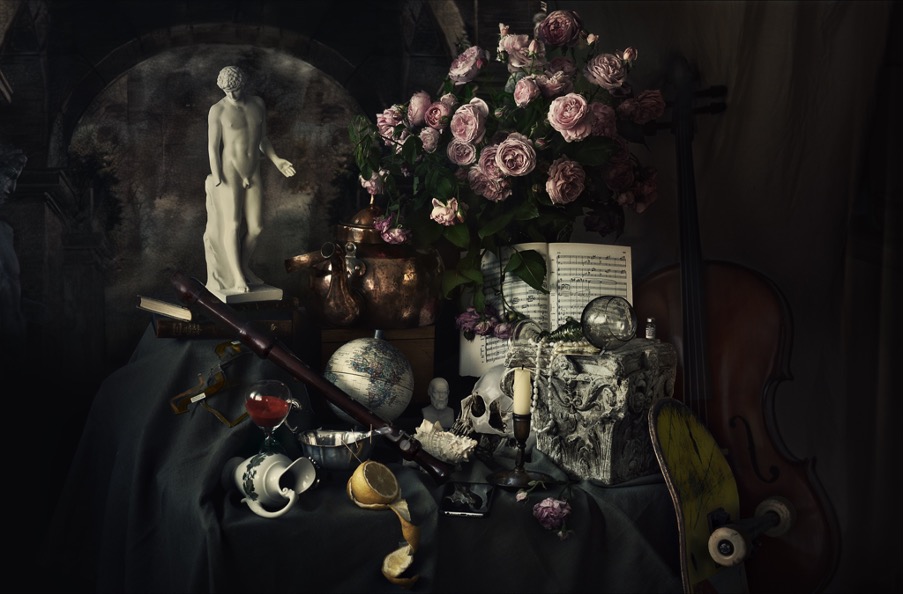
Skills (Vanitas)
2022, Photograph, C-Print with Frame, 90 x 165 cm, Ed. 1/3
|
Skills for Peace, the fourth edition of the POINTS of RESISTANCE exhibition series, derives its name from the still life Skills, by the renowned German composer Sven Helbig. Created in the style of baroque vanitas painting, it depicts, among other things, a vaccine vial, a skateboard, his iPhone, and the cables of his first computer under the neutered protective gesture of Hermes, the messenger of the gods, in addition to the common attributes of the still life genre. The central score features Strauss’s setting of Nietzsche’s Thus Spoke Zarathustra. The deformed Hermes thereby reveals the dual questions: that of the divine idea, and that of the self-conquest of man without God as proclaimed by Nietzsche. The question remains: what in today’s secular present can all people of this earth connect with after thousands of years of cultural history? It is peace, one should think. We should have the skills for it – after all that was. Skills for Peace lives in this field – between hymn and melancholy. Sven Helbig’s photographic work Skills, was made in parallel to his new Symphony, also entitled Skills, to be performed on Easter Sunday within the POINTS of RESISTANCE: Skills for Peace exhibition in the Zionskirche.
ARTIST STATEMENT: In my parents’ living room stands an elaborately hand-forged copper kettle – my grandfather’s masterpiece, hammered out of a single piece of copper. Growing up in a family of craftsmen, I have been familiar since early childhood with the attitude of perfecting a thing for its own sake. The deepening concentration and slow maturing of execution, the craft shares with spiritual rituals, with arts, sports and the sciences. I am touched by the sight of almost ideal expressions of human activity, be it a forged piece, a perfectly build sentence or an athletic performance. I dedicate my album SKILLS to this fascination.
|
Sven Helbig (born in Eisenhüttenstadt in 1968) is a German composer, director and music producer. Helbig’s symphonic images are closely connected to his life, experiences, aspirations and also the voids between epochs, systems and continents. In 2003 he produced the project “Mein Herz Brennt” (My Heart Burns) based on song ideas by Rammstein. A year later he performed “Battleship Potemkin” with the Pet Shop Boys, and in 2009, he recorded with the Fauré Quartett as producer of their “Popsongs” album. The friction between the feeling of security of yesteryear and the challenges of the present is one of his central motifs. In this respect, Helbig’s little symphonies are in fact substantial works, for they continue to expand within their framework. Helbig’s versatility has made him a much sought-after producer for crossover projects; he has worked as a producer, composer and arranger with Snoop Dogg, Polarkreis 18, opera singer René Pape, pianist Olga Scheps and more. Helbig’s work builds on the tradition of the Gesamtkunstwerk (all-embracing art form) and he often takes responsibility for content, music and production at the same time. Helbig currently lives and works in Dresden. |
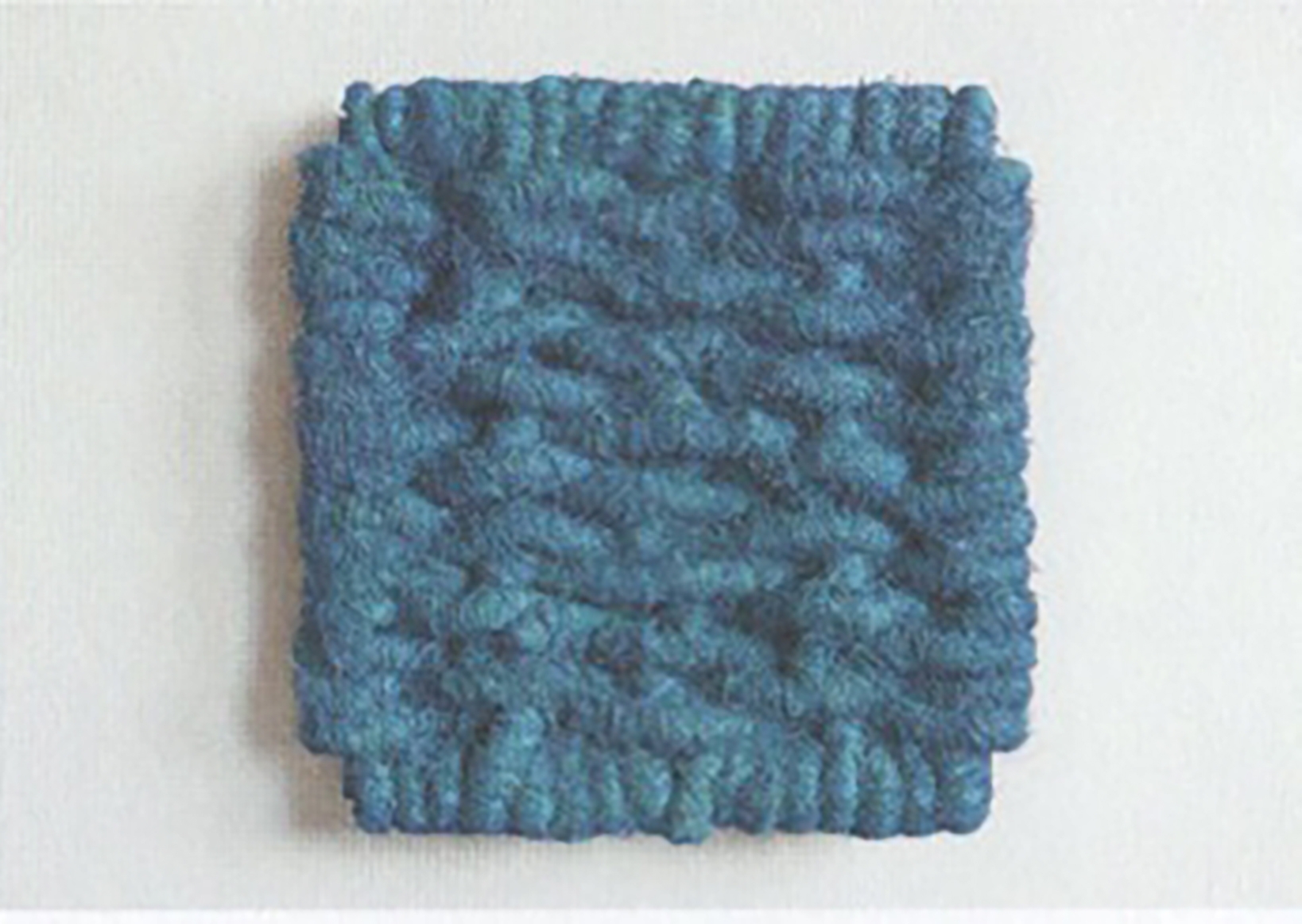
Lichtbild Leinen Blau / Linen Blue Photo
2014, Hay, Wire, Ash, Pigment, 130 x 120 x 25 cm
Courtesy of Daniel Marzona
|
Olaf Holzapfel, born in Dresden in 1967, is an artist from a country that no longer exists. His coming-of-age involved crossing a border between the East-West divide of the Cold War era that – until the current outbreak of war in Ukraine – was becoming a distant memory. Holzapfel has long been interested in boundaries, demarcations, and frontiers – or, more precisely, in interstitial spaces, what is possible in between. With Europe’s anxiety surrounding its porous borders now central, sadly enough, to its paranoid sense of self, Holzapfel’s work could not be more timely and more apt, choosing to shift his gaze to a frontier far from the eastern Mediterranean, namely in south-central Chile, the past site of a number of Holzapfel’s projects; all of which have involved close cooperation with the local population and an elemental reliance on Indigenous traditions of building, constructing, and manufacturing. Holzapfel’s new pictures made of straw and cactus fibers describe the relationship between human and landscape; they translate space into surfaces. These are material pictures of the periphery – straw pictures from Lusatia and Brandenburg, chaguar plant fiber pictures from the dry forests of the Chaco in northern Argentina, pictures and folds of interconnected straw, line spaces in which light is refracted, reticulated woven textile pictures of cactus fibers colored with materials extracted from the plants in the environs. In them, traditional motifs are combined with contemporary compositions of paths, spirals, and fields to yield landscape-like pictorial spaces. Holzapfel’s works, created with ancient craft techniques, blur, within contemporary art, the strict separation of nature and culture. Are line spaces and networks exclusively contemporary terms of a digitalized, media world? Holzapfel’s dealings with living forms of crafts suggest that the contradiction between tradition and modernity can be viewed as a bygone construct, as mere appearance that glorifies landscape as an Arcadian subconscious. Instead, the artist is interested in landscape as a reservoir of its own media technology, with a presence of the approximate, of the recurring dimensions of plants, of the systematics of even inhospitable rural regions. He thereby counters a view of truth and reality shaped by theoretical conceptions with an action and the material that lead to a picture. The spaces that are meanwhile virtually retrievable everywhere and at all times via GPS coordinates or actually as urban space are juxtaposed and compared with what we call nature, wilderness, or landscape to produce the disturbing fascination of his new works. Until now, nature was usually perceived as a depiction or a resource – whereby it produces its pictures in direct exchange with itself. Thus, Holzapfel’s pictures tell us something about our relationship to nature and landscape, about our relational being, about the similarity and comparability of modern and archaic, urban and rural models of spatial organization. They draw their beauty from their simultaneity – they originate from the interior of the landscape in which they are made, and the question arises whether these pictures of the periphery are not in reality the beginning of a new center and perhaps already inscribed in it, and whether the contradiction between wilderness and order, between nature and culture actually exists or is only a theoretical construct that keeps us within the interior of a human egocentrism and blocks our view of their natural kinship. The first chaguar pictures were created in collaboration with the northern Argentinian Indios, the Wichis, and were first exhibited in 2009 in Buenos Aires and then at the Venice Biennale 2011. Later, Holzapfel created additional individual pictures that can now be viewed as autonomous pictorial works. They provide examples of the ambiguity of seemingly fixed categories of a modernity enclosed within itself and prepared for random access. For it remains simply unclear whether their theme is determined by a recollection of the Bauhaus, by digital designs, or by the technique and craft of the Indios. Holzapfel’s artistic practice thus proves once more to be shaped by a nomadic, alternative thinking that includes the fissure and that brings contraries together to advance to new shores. – Daniel Marzona
|
Olaf Holzapfel (born in Dresden, 1967) is a German contemporary artist. First featured in Ausgesucht von Thomas Scheibitz at Koch und Kesslau in Berlin in 2003, his work is particularly well-known in Germany, Belgium and Switzerland, having been exhibited with Eberhard Havekost and Frank Nitsche. He was notably featured in the 54th Biennale di Venezia (2011) and in documenta14 (2017). |
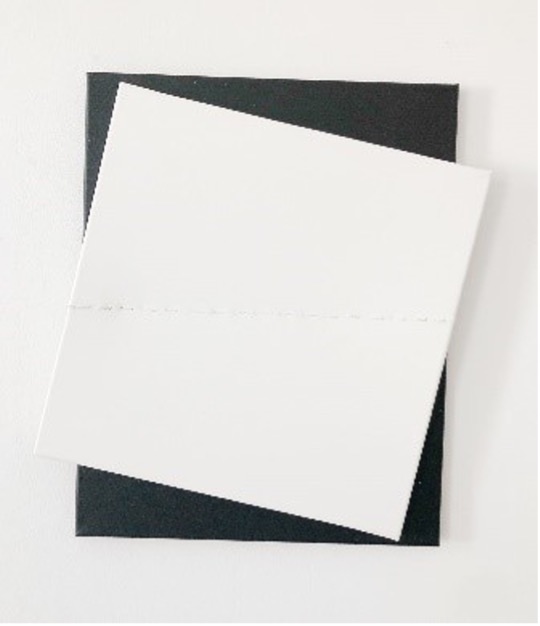
Ohne Titel / Untitled
2022, Acrylic on canvas, 50 x 40 cm
|
A fortuitous cojoiing of Malevich’s Black Square and White Square – Huang Jia’s spatial painting is a minefield of optical illuson. Made of opposing planes of straight lnes, it nevertheless defies the eye to percieve it as straight. Leaving the viewer with an uneasy sensation that something is somewhat out of joint, it could be an allegory for our twisted times – a world skewed by war and disease off of the straight line which was once our perception of normal.
|
Huang Jia (born in China in 1964), is a painter and well-respected representative of minimalist conceptual painting. Her work goes from figurative to minimalist, combining basic concave and convex forms in differing permutations attempting to demonstrate, that varying psychologies and the collective unconsciousness can be transmitted through the simplest visual symbols. Huang Jia’s “Waiting for New Hairstyle” series was selected into Guangzhou Biennale 1992 and her early works were inspired by Francis Bacon, Paul Delvaux and Lucian Freud, focusing on self expression and construction. To give our readers a broader perspective of her works and practice we arranged an interview with Huang Jia. She currently lives and works in Shenzhen. |
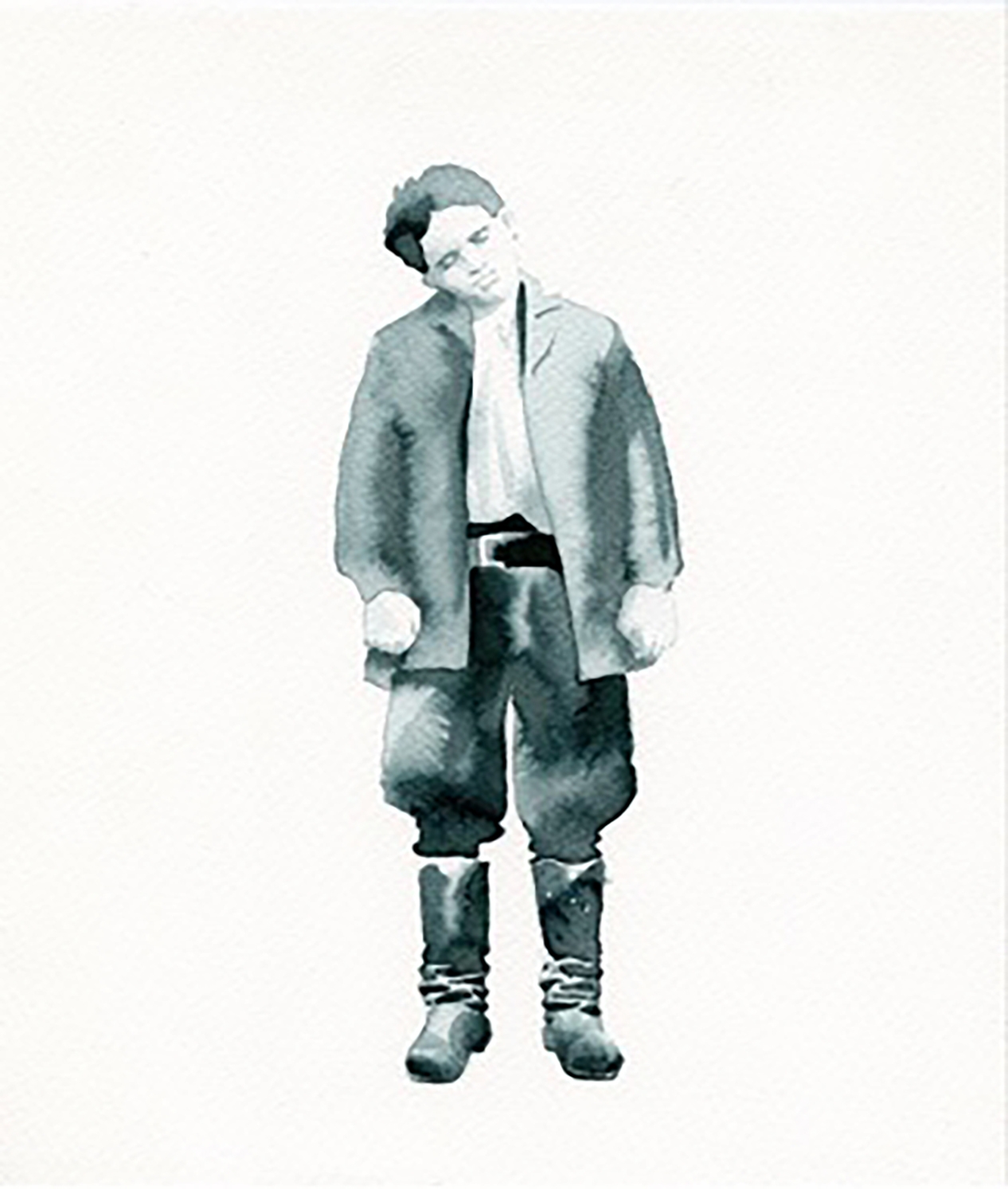
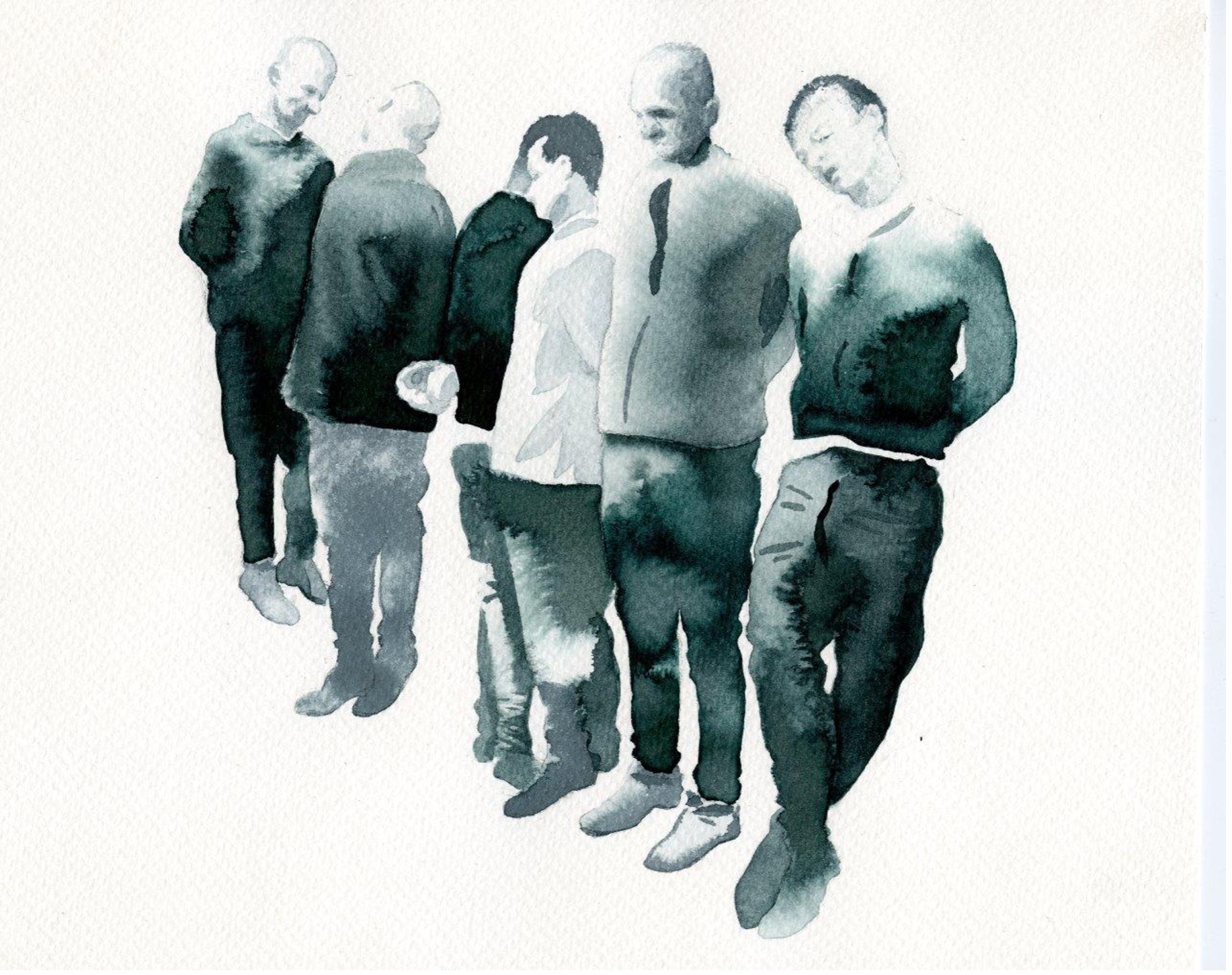
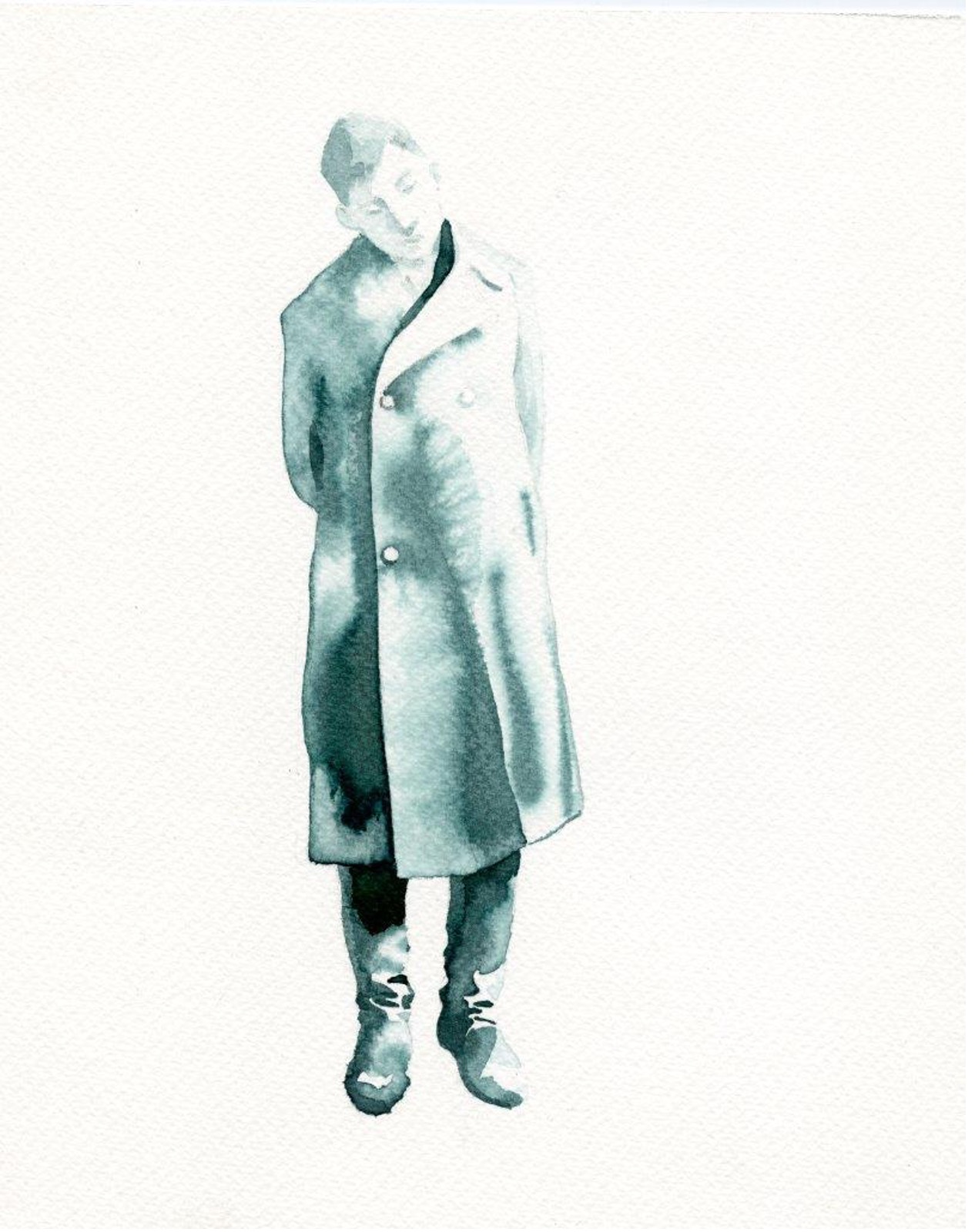

4 Aquarelle
Watercolor on paper, 25,2 x 20 cm
|
Predating the current attrocities of war in Ukraine, but poignanty relavent now, is this series of watercolors of excecuted Ukrainian soldiers and civilians.
|
Nikita Kadan (born in Kiev in 1982) is one of the leading personas of Ukrainian art. Kadan works with painting, graphics, and installation, often in interdisciplinary collaboration with architects, sociologists and human rights activists. He is a member of the artist group R.E.P. (Revolutionary Experimental Space) and founding member of Hudrada (Artistic Committee), a curatorial and activist collective. Nikita Kadan represented Ukraine at the Venice Biennale in 2015. He has been awarded the Kazimir Malevich Prize, 2016; the Future Generation Prize (special prize), 2014; the Maiмn Prize, PinchukArtCentre Prize, 2011; and he was shortlisted for the PinchukArtCentre Prize in 2009 and for Future Generation Prize in 2012. His works are featured in the public collections of Pinakothek der Moderne, Munich, M HKA; Museum of Contemporary Art Antwerp; mumok (Museum Moderner Kunst Stiftung Ludwig Wien); National Art Museum of Ukraine, Kyiv; Arsenal Gallery, Białystok; Military History Museum, Dresden; The Art Collection Telekom, Krasnoyarsk; museum centre, Krasnoyarsk; The Kingdom of Belgium, Ministry of Foreign Affairs; FRAC Bretagne; Centro per l’arte contemporanea Luigi Pecci, Prato; Сentre Pompidou in Paris. |
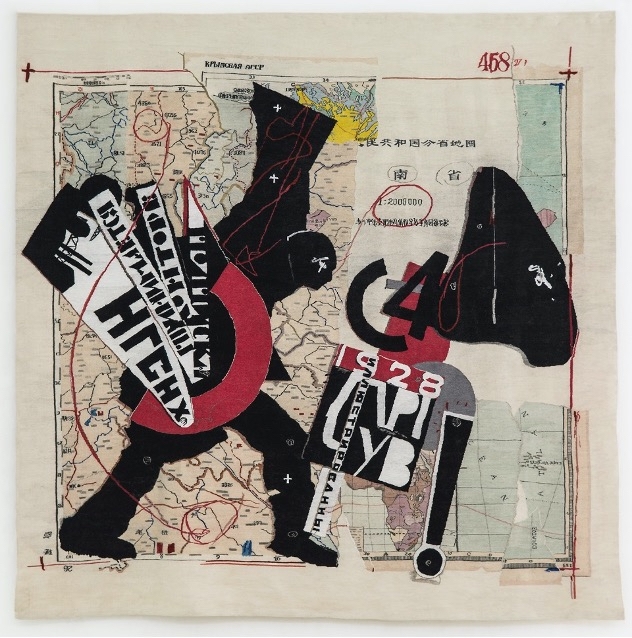
Processional Nose
2015, Mohair Tapestry, woven by the Stephens Tapestry Studio, Johannesburg, South Africa, 258 x 257 cm, Ed. 1/6
Courtesy of Galerie Kewenig, Berlin, and Goodman Gallery, Johannesburg
|
Kentridge’s studio states: For the stage design of the opera, on top of projections of human figures, paper cut-outs were added and interposed, trying to find a link between the constructivist language of El Lissitzky and the earthy language of Gorky and the Russian filmmakers. Languages which were very different at the time and even antithetical, but which in hindsight are joined by a sense of openness, of possibility, of agency. As if the upheavals of the 1917 revolution could provide an energy for new images, new words, a new language. We know the post-history.” This painful post-history comes back to haunt us today, with Russia’s aggressive imperialist ambitions and tragic regression to the punitive measures of Stalinist times. It is becoming a country divided against its own people, as well as a nation seeking to restore long-lost borders. https://www.kentridge.studio/projects/the-nose/
|
William Kentridge (born in Johannesburg in 1955) is a South African artist best known for his prints, drawings, and animated films. The latter are constructed by filming a drawing, making erasures and changes, and filming it again. He continues this process meticulously, giving each change to the drawing a quarter of a second to two seconds’ screen time. A single drawing will be altered and filmed this way until the end of a scene. These palimpsest-like drawings are later displayed along with the films as finished pieces of art. His works have been exhibited in solo exhibitions at many museums, including Centre de Cultura Contemporània de Barcelona (CCCB), Barcelona (2020), Liebegshaus, Frankfurt (2018), MAXXI, Rome (2013), MACO, Oaxaca (2011), Louvre, Paris, (2010), Chicago Museum of Contemporary Art (2009), Philadelphia Museum of Art, Philadelphia, Pennsylvania (2007), Museum of Modern Art, New York (2007), Museum der Moderne, Salzburg (2006). Since the 1980s, Kentridge has been awarded various prizes, such as the Kaiserring Prize, the Carnegie Prize, the Standard Bank Young Artist Award, and the Red Ribbon Award for Short Fiction. He currently lives and works in Johannesburg, South Africa. Kentridge’s works are included in the following permanent collections: Honolulu Museum of Art, the Kalamazoo Institute of Arts, the Museum of Contemporary Art, Chicago, the Museum of Modern Art (New York), and the Tate Modern (London). An edition of the five-channel video installation The Refusal of Time (2012), which debuted at documenta 13, was jointly acquired by the Metropolitan Museum of Art in New York and the San Francisco Museum of Modern Art. In 2015, Kentridge gave the definitive collection of his archive and art – films, videos and digital works – to the George Eastman Museum, one of the world’s largest and oldest photography and film collections. |
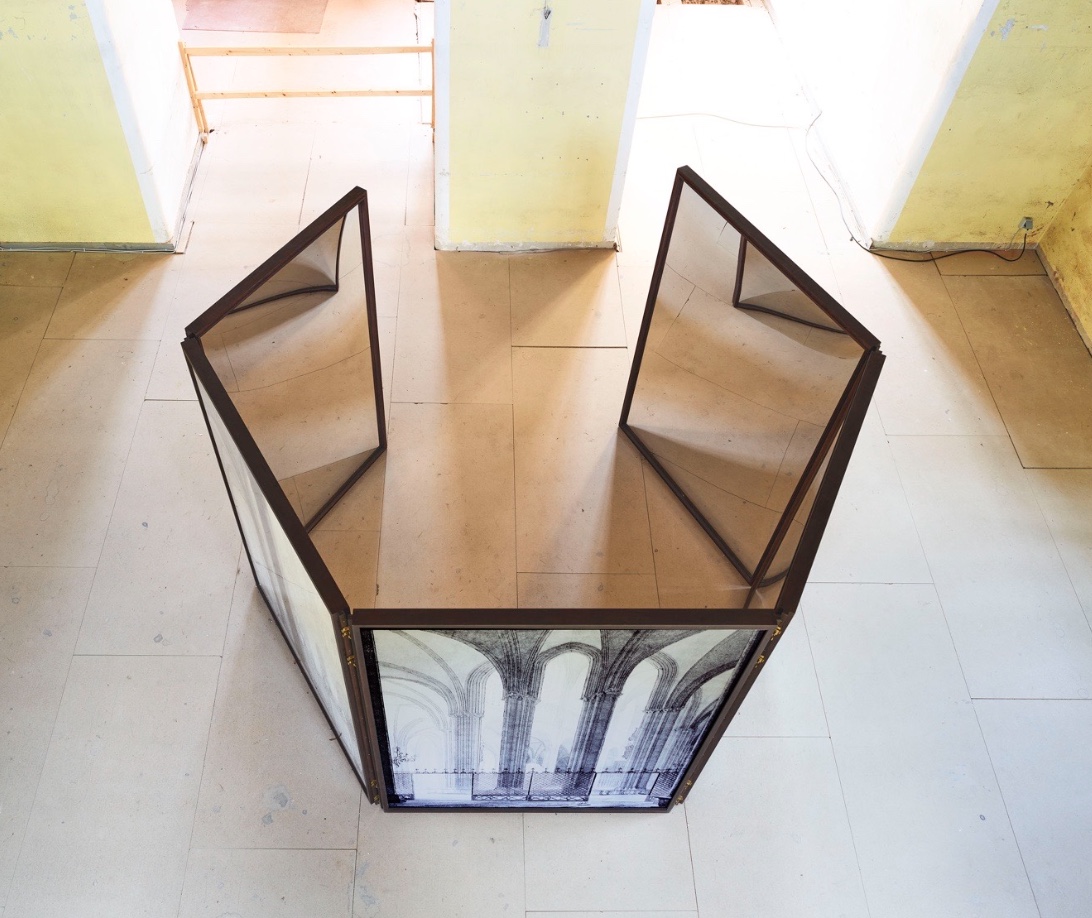
Das Ist Der Dom in Coeln I
2019, 5 panels, 226 x 777cm, mirrors, matt archive inkjet prints in artist frame, Ed. 2
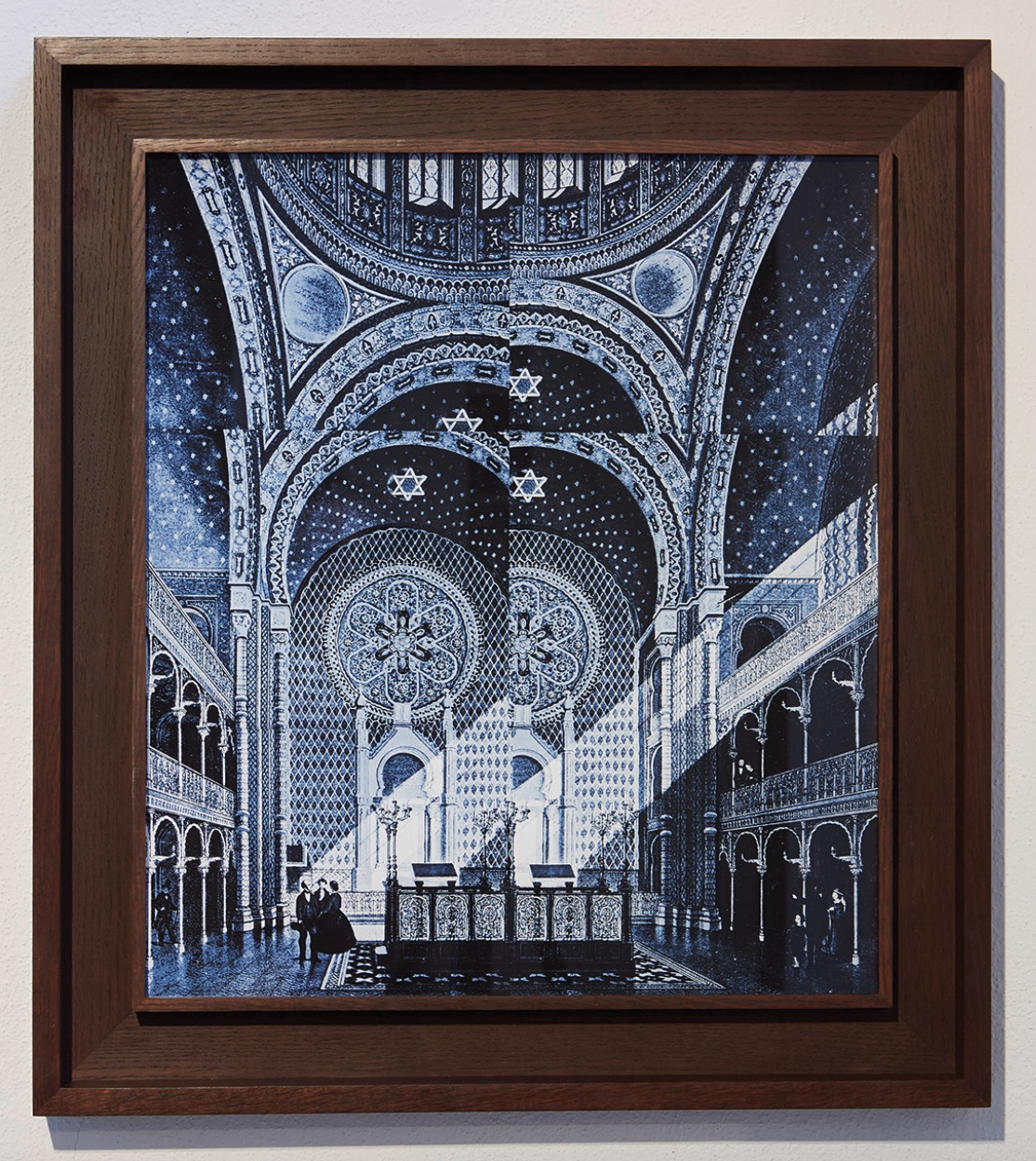
Synagogue Glockenkasse 1861 (Destroyed 9.11.38)
2019, 75 x 68 cm
|
Places of worship have, throughout human history, played a significant role in times of conflict and war. They are places of hope and redemption where we come to pray for peace. But also – alas – they have historically represented the causes of many conflicts, from the religious wars and inquisitions of the Crusades, to more recent conflicts around the world. With the outbreak of war once more in Europe threatening to engulf the world, Ola Kolehmainen’s work in POINTS of RESISTANCE IV: Skills for Peace is presented with this duality in mind. It is both a reflection on the greatness of human endeavor in building architectural marvels in the glorification of God, and the human potential for evil in destroying those same marvels in the name of dogmas and ideologies. – Dr. Johanna Gummlich,
|
Ola Kolehmainen (born in Helsinki in 1964), has lived and worked in Berlin since 2005. He studied at the University of Art and Design, Helsinki (TaiK) and became one of the most visible and successful artists of the first Helsinki School generation in the first decade of the 21st century. He is known for his minimalistic and abstract pictures of modern architecture, with a special interest in the work of modern masters such as Alvar Aalto and Mies van der Rohe. His current more narrative works focus on exteriors and interiors of sacred buildings that he started after spending an intense work phase in Istanbul in 2014 researching buildings of the Ottoman and Byzantine Period. The Berlin-based artist is one of the leading figures in Finnish photography. His work is included in multiple international art institutions, foundations, and collections, from Germany and Spain to renowned Nordic museums such as the Malmö Art Museum and the Museum of Contemporary Art Kiasma. Galerie Forsblom has been representing Ola Kolehmainen since 2011. |
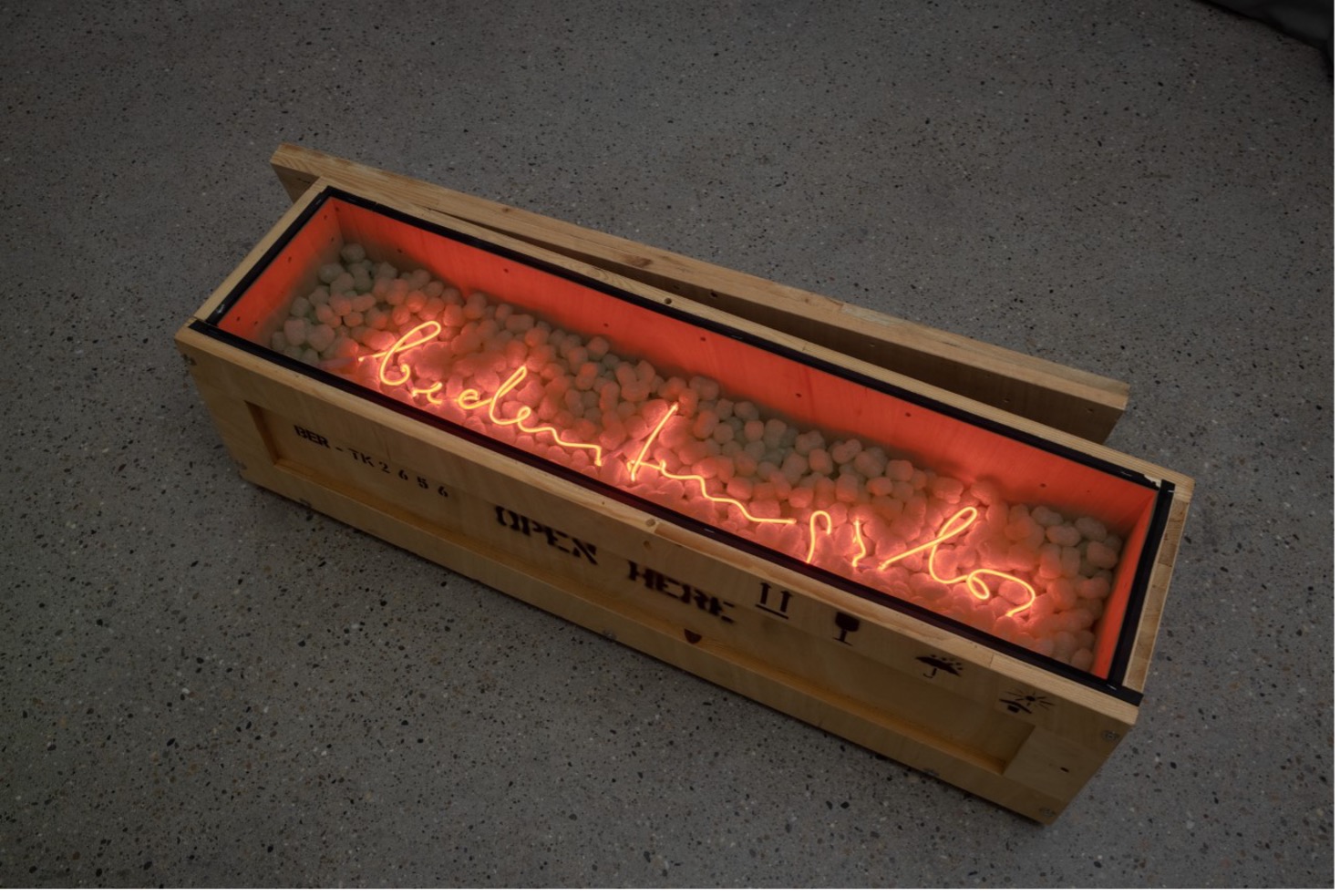
Und dann das / And then this
2021, Neon, Wooden Box, 35 x 30 x 130 cm
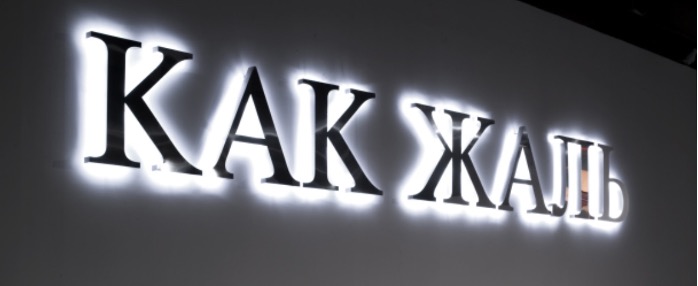
как жаль (ach, schade) / what a shame
2009/2022, Text with Neon, 25 x 120 cm
|
Via Lewandowsky’s works speak for themselves. The two text pieces spell out a scathing portrait of our times. Inside its own packing crate is nestled a red neon word meaning ‘senseless’. Originally intended by the artist as a caustic comment on the art market, this work and the sentiment behind it are even more applicable to our situation today with the senseless outbreak of war in Ukraine. While the translated title of как жаль (What A Shame), executed in glowing Cyrillic letters, doesn’t begin to cover the profound pathos of this short phrase in the original Russian. What a shame, indeed, that violence and repression have returned again to a people who have already endured so much. Having been born and raised in the DDR, Via Lewandowsky in his work often voices his resentment at the legacies of this repressive political system with bittersweet humor. Yet there is no room for humor in the atrocities of war unfolding in Ukraine right now, and как жаль (What A Shame), as a statement of our times, remains simply bittersweet.
|
Via Lewandowsky (born in Dresden in 1963), is a contemporary artist based in Berlin. He studied at the Dresden University of Fine Arts from 1982 to 1987. Between 1985 and 1989 he organized subversive performances with the avant-garde group “Auto-Perforations-Artisten”, which subverted the official art scene of the GDR. His multimedia practice focuses on sculptural-installational works and exhibition scenographies with architectural influences. His leitmotifs are always the misunderstanding as a result of failure of communication, as well as the processual. An ironic refraction of the everyday, the intrusion of the foreign into the familiar, mostly domestic, realm, often happens by using insignia of the German bourgeoisie (e.g. a cuckoo clock, or a budgie). His predilection for the tragic-comical, the absurd and paradoxical, as well as the Sisyphean motif of the constant repetition and futility of action connect his art with Dadaism, Surrealism and Fluxus. Via Lewandowsky’s works have been shown worldwide in solo and group exhibitions, most recently at the Jewish Museum, Berlin (2020), Künstlerhaus Bethanien, Berlin (2019), Bongsan Cultural Center in South Korea (2019), Shedhalle, Zurich (2018), David Nolan Gallery, New York (2017), Museum of Fine Arts Leipzig (2016) or Kunsthalle zu Kiel (2015). |
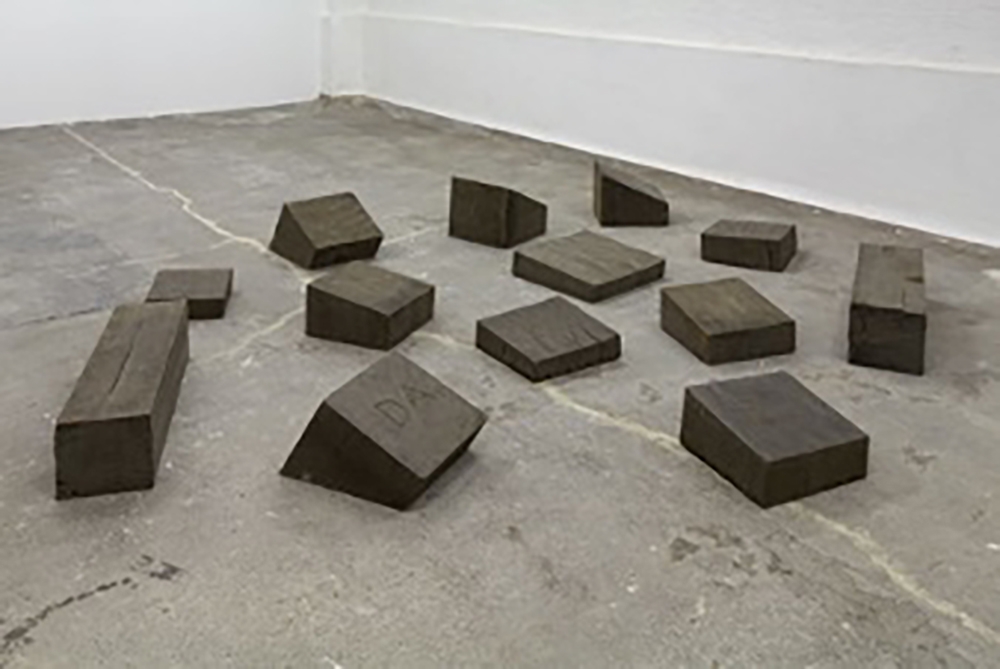
Untitled
2001, Wood engraved with text, 28,5 x 264 x 253 cm
|
Bernd Lohaus’s oeuvre gives a voice to the material. Since the late 1960s, wood, rope, and later also stone and bronze have been the working materials of elemental sculptures in which the raw and the fragile interlink and in which flotsam found in the water gains a new artistic life of its own with a few simple interventions. Along with the usually block-like and expansive sculptures stand reduced works on paper and raw canvas pieces – “coudrages” – with similar, powerfully expressive simplicity; some are inscribed with a few words as if with pictorial poetic exclamations, while in other cases, they are marked with bar-like brown strips of tape that cut out space, sometimes accented with energetic strokes of color. Because the material points beyond itself to the realm of feeling, thinking, language, and back to history and nature, Lohaus’s sculptural oeuvre is an expansion of traditional sculptural forms of expression. It connects the material with spirituality. Bernd Lohaus created his first works directly in Beuys’s class, and they were exhibited in the gallery circuit of the Academy at that time. Since then, in its various forms of expression, the oeuvre has continued to develop in the sense of a progressing dialog with itself and the world. Lohaus has also repeatedly placed large ensembles in natural surroundings. Bernd Lohaus was born in Dusseldorf in 1940 and died in Antwerp in 2010. In 1965, he and his wife Anny De Decker founded Antwerp’s Wide White Space Gallery (until 1976). After beginning with Fluxus-like Happenings, in 1969 he had his international artistic debut at Harald Szeemann’s exhibition “When Attitudes Become Form” in the Kunsthalle Bern. In September 2014, Daniel Marzona opened his Berlin gallery programmatically with a solo exhibition by this pioneering artist. – Stephan von Wiese
|
Bernd Lohaus (born in Germany in 1940) is a contemporary artist. Lohaus is represented by multiple galleries around the world, such as Georg Kargl Fine Arts in Vienna, Galerie Bernard Bouche in Paris, and Daniel Marzona in Berlin. His works have been shown at Geukens & De Vil in Antwerp with the exhibition PRESQUE RIEN; at Sofie Van de Velde in Antwerp; at Galerie Bernard Bouche in Paris. |
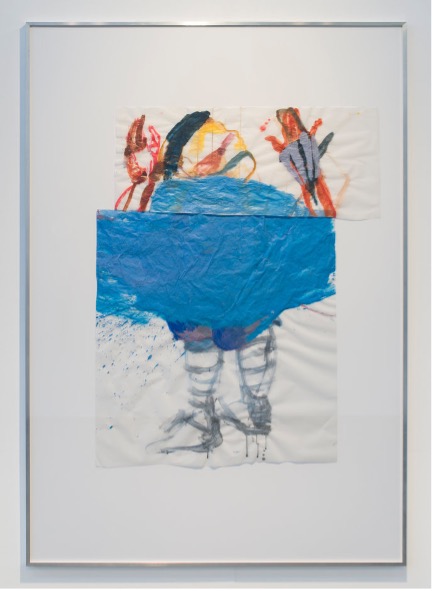
Fahrt ins Blaue (Himmelfahrt 2) / Journey to the Blue (Ascension 2)
2019, Egg Tempera on Transparent Paper, 220 x 114 cm
|
Journey to the Blue (Ascension 2) is one of many possible combinations of the group of works Konvolut Möglichkeiten / Convoluted Possibilites, which Sarah Loibl continues since 2016. Countless studies on transparent paper webs, which on the one hand serve Loibl as preparation for her up to 3.60m large wall-related paintings and on the other hand – folded, cut and recombined again and again – investigate and thematize mobility and action space of pictorial thinking as changing image assemblies. In a frame, pinned to the wall, or layered as a loose pile on rolling carts, they form a contradictory joint, emphasizing process, movement, and the assertion of always possible shifts.
|
Sarah Loibl (born in Munich, Germany in 1987) is a contemporary artist. She graduated at University of Fine Arts, Berlin, 2017. Her work is strongly connected to movement and distances. Her Solo Exhibitions include “Win Heart”, Art Center Ongoing, Tokyo (2015), “Four possibilities to run against a wall” (2018). Her group exhibitions include “Canvas”, Tschechisches Zentrum, Berlin (2018), “Ten Years Regina Pistor”, Berlin (2018), “Meisterschülerausstellung”, UdK Berlin (2017), “What stayed from Fichten”, Max Planck Institute for arts and research, Berlin (2017), “Berlin stoneprints from the last decade”, Galeria ASP, Gdansk, Poland (2016), “Five caps”, Galeria Kaufhof am Alexanderplatz, Berlin (2016), “young positions”, Galerie Pankow, Berlin (2015), “Druckgrafik Plastik”, Kunstraum Heiddorf (2015), “Das Atelier für Lithographie”, Printing Museum, Lublin, Poland (2015), “Physis”, market place and court of Veria, Greece (2013), “Projekt Physis”, griechische Kulturstiftung, Berlin (2013). |
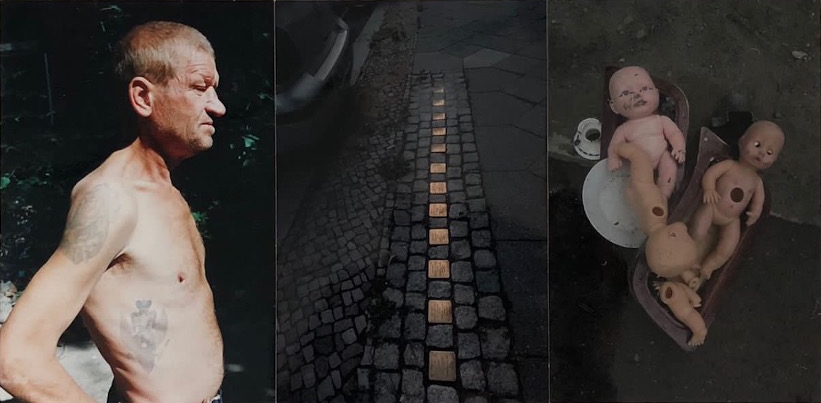
Untitled
Color photography, triptich, 40 x 50 cm, Unique work
|
Boris Mikhailov’s images bring to life one of the most tumultuous chapters of the 20th century: the height, decline, and fall of the Soviet Union and its disturbing aftermath. Yet as they chart this extraordinary history, they also express the complex emotions and intellectual subtlety of a powerful artist. Mikhailov’s work ranges from the covert transgressions of a critical mind under a totalitarian regime to the tender depictions of daily life. The world in his pictures is always unadorned and raw – everyday scenes, poverty, sexuality, despair, resignation, the decline of a forgotten Eastern Europe. Mikhailov, always dedicated to the outcasts of society, explores the position of the individual within the historical mechanisms of public ideology, touching on such subjects as Ukraine under Soviet rule, the living conditions in post-communist Eastern Europe, and the fallen ideals of the Soviet Union. Although deeply rooted in a historical context, Mikhailov’s work also incorporates profoundly engaging and personal narratives of humor, lust, vulnerability, aging, and death.
|
Boris Mikhailov (born in the USSR in 1938), is a Ukrainian photographer living and working between Kharkiv and Berlin. He has been described as one of the most important artists to have emerged from the former USSR. Mikhailov studied electrical engineering at Kharkov Technical University and initially worked as an engineer before he began taking photographs as a self-taught photographer in the late 1960s. The early series of the 1960s and 70s often show personal images of friends, acquaintances or partners of the artist. Boris Mikhailov’s works have been presented in countless solo and group exhibitions worldwide. Mikhailov represented Ukraine in the 57th Venice Biennale (2017), and also participated in the 52nd Venice Biennale (2007). Other recent solo exhibitions include: Staatliche Kunsthalle Baden-Baden (2019); Before Sleep/After Drinking, C/O Berlin Foundation, Berlin (2019); Fotomuseum, Antwerp (2016); Kunstverein Wolfenbüttel (2016); MADRE, Naples (2015); Camera Italian Centre for Photography, Turin (2015); Sprengel Museum, Hannover (2013); Museum of Modern Art, New York (2011); Tate Modern, London (2010); and Kunsthalle Wien, Vienna (2010). Selected group exhibitions include: Staatliche Kunstsammlungen (2021); Bruce Museum, Greenwich, USA (2018); Stedelijk Museum Amesterdam (2018); ‘Another Kind of Life: Photography on the Margins’, Barbican Centre, London (2018); 5th Odessa biennale (2017); ‘The Human Condition Session II’, Moscow Museum of Modern Art (2016). Mikhailov was the recipient of the 2016 Goslar Kaiserring Prize; the 2012 Spectrum International Prize for Photography; the Citibank 2001 Photography Prize; and the 2000 Hasselblad Foundation International Award, among others. His work is included in important public collections, including: Hamburger Bahnof, Berlin; ICA, Boston; Museum of Contemporary Photography, Chicago; San Francisco Museum of Modern Art; Stedelijk Museum, Amsterdam; Tate Modern, London; Tel Aviv Museum of Art; The Metropolitan Museum of Art, New York; MoMA, New York. |
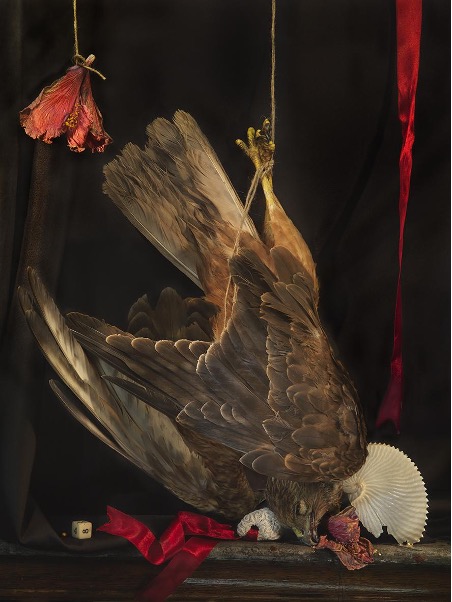
Young Hawk, Hag Stone and Paper Nautilus, Ripiro Beach
2014, Photograph printed on canvas, 108 x 144 cm
Courtesy of the MOMENTUM Collection
|
Young Hawk, Hag Stone and Paper Nautilus, Ripiro Beach is one of a series of photograps from Fiona Pardington’s Ex Vivo series. Like so much of her work from this period, it is a still life made in the vantias tradition – a way to exalt life through reminders of mortality. “Twice a day the tides that lave and redraft the coastline wash up a diversity of bounty: driftwood, kelp, shells, dead crabs, bones, fishing floats, perhaps a rare paper nautilus,and occasional hints of life in the deep interior depths and cool green hells, or over the blue horizon. After a big storm, more than likely there will be dead seagulls and albatrosses too, studies in greyscale. New Zealand’s long and supine coastline acts like a driftnet, gathering it all up. You never know what gifts Tangaroa will surprise you with, which is part of the magic of it all. If it floats, and falls into the Tasman, the Pacific, the freezing Southern Ocean, or perhaps further afield, hidden currents will probably wash it up on our sand or shingle for a beachcomber to find. It is beachcombing which provided most of the objets trouvés for this suite of works by Fiona Pardington. Appropriately enough, it starts out as a Pacific phenomenon. The first appearance of the word in print is to be found in Herman Melville’s 1847 novel Omoo which described a community of feckless and outcast Europeans in the Islands who had abandoned Western culture for a life “combing” the beach for anything they could use or trade. Not for the faint of heart, Sappho warns the squeamish against poking the coastal rubble; Μὴ κίνη χέραδασ. While living in Waiheke Island, Fiona regularly explored Rock Bay and Ontetangi beaches, and later Ripiro and Bayley’s Beach, walking her canine menagerie. She, also, was looking for things to use and trade, though these transactions are of an entirely aesthetic sort. She is, as Shakespeare writes of Autolycus in The Winter’s Tale, “a snapper-up of unconsidered trifles”. The albatross feathers allude to the artist’s great love of nature and her Ngāi Tahu, Kati Mamoe and Ngāti Kahungunu ancestry – Māori associations with the deep water, long voyages and return. To Māori, albatrosses, Torora, represented beauty, grace and power, and their feathers and bone were worn by people of rank or adorned the prow of waka taua (war canoes). The (with a nod to Monty Python) ex-gulls. Karoro, the blackbacked gull, were kept as pets by some Māori to control vermin, and were considered an ill omen seen inland. The objects that look like white wax flowers and the plastic casings of fired rifle cartridges. These can be considered symbols of explosive and potentially dangerous energy and transformation. The philosophy of collecting and salvage moves like an eel up the river from the coast. Like the carnage from the Māori legend of the battle between the sea birds and the land birds, among the fallen, mingling with the gulls and albatrosses are a humdrum sparrow and a young kāhu (hawk). Te kāhu i runga whakaaorangi ana e rā, / Te pērā koia tōku rite, inawa ē! (“The hawk up above moves like clouds in the sky. Let me do the same!”). Here, too, are items that have washed up from the human sea; a crystal ball, a pounamu heart (the heart of Fiona’s whakapapa lies among the iwi of Te Wai Pounamu, the South Island), a hag stone (a stone naturally pierced by water through which those gifted with second sight were, according to legend, supposed to see the future and the other world through, a pewter mug, roses, and a cut glass decanter of water from Lake Wakatipu. Transparent and fragile vessels are important in Fiona’s work, alluding to the tradition of Vanitas painting (remember, you too shall one day die) and often containing water from places significant to the artist. These lustrous objects also reveal Fiona’s virtuosity with light, and photography, after all, is Classical Greek for drawing or writing with light. The eye scavenges. – Andrew Paul Wood (2014)
|
Dr Fiona Pardington was born in Auckland, and is of Maori (Ngāi Tahu, Kati Mamoe and Ngāti Kahungunu) and Scottish (Clan Cameron of Erracht) descent. She holds a Doctorate in Fine Arts from the University of Auckland, and lives and works in New Zealand. An abiding concern with emotion and affect is at the heart of Fiona Pardington’s photographic practice. With over three decades experience as an exhibiting artist, she has continued to explore the capacities of photography by attending to what is hidden or unseen in the photograph as much as what it may represent. In the late 1980s she was among a group of women artists who challenged photography’s social documentary aesthetic, prevalent in the previous decade. She went on to focus on the still-life format, recording Museum taonga (Māori ancestral treasures) and other historic objects such as hei tiki (greenstone pendants) and the now extinct huia bird. Thus she brings an awareness of traditional and forgotten objects to contemporary audiences. Pardington is renowned for her ability to breathe the life force into these objects and to raise global awareness of the importance of conservation. In her interrogation of death, she celebrates collecting and preservation. In 2016 Pardington was named a Knight (Chevalier) in the Order of Arts and Letters (Chevalier de l’ordre des Arts et des Lettres) by the French Prime Minister, and she is the first New Zealand visual artist to receive this honour. Last year she was made a Member of the New Zealand Order of Merit. Fiona Pardington has received many fellowships, residencies, awards and grants, including the Moët et Chandon Fellowship (France) in 1991-92; the Frances Hodgkins Fellowship in both 1996 and 1997; a Ngai Tahu residency at Otago Polytechnic in 2006; and both the Quai Branly Laureate award, La Résidence de Photoquai, and the Arts Foundation Laureate Award in 2011. Pardington has created staggering works as a result of these opportunities. Her work has been included in several important group exhibitions and biennales, including: Middle of Now|Here, Honolulu Biennial 2017; lux et tenebris Momentum Worldwide, Berlin 2014; The Best of Times, The Worst of Times. Rebirth and Apocalypse in Contemporary Art, Ukraine Biennale Arsenale 2012; Ahua: A beautiful hesitation, 17th Biennale of Sydney, 2010; Imposing Narratives: Beyond the Documentary in Recent New Zealand Photography, 1989, Constructed Intimacies, 1989 and Now See Hear 1990. Prospect 2001: New Art New Zealand, all at the City Art Gallery, Wellington; Slow Release: Recent Photography from New Zealand, Heide Museum of Modern Art Melbourne, Australia and the Adam Gallery, Wellington, 2002; Te Puawai O Ngai Tahu, Christchurch Art Gallery and Pressing Flesh, Skin, Touch Intimacy, Auckland Art Gallery Toi o Tamaki in 2003; and Contemporary New Zealand Photographers, Pataka’s International Arts Festival, Porirua, 2006. In 2008 the New Zealand Government donated a suite of her heitiki prints to the then newly-opened musée du quai Branly, Paris. A similar work auctioned in Auckland realised the highest price in New Zealand for a photographic work at auction. Fiona returned from Paris where she completed a Laureate Artistic Creations Project with musée du quai Branly in 2011. In the same year the Govett-Brewster Gallery and the Dunedin Public Art Gallery presented The Pressure of Sunlight Falling, a series of photographs of life casts made by medical scientist and phrenologist Pierre Dumoutier during one of French explorer Jules Dumont d’Urville’s South Pacific voyages from 1837 to 1840. An accompanying catalogue was published by Otago University Press. This series has continued to be exhibited and discussed by academics and curators from all over the world and will feature in Oceania which opens at London’s Royal Academy of Arts in September 2018 and then travels to the co-organising institution musée du quai Branly – Jacques Chirac in Paris. Australian art historian Susan Best, in her book Reparative aesthetics which closely examines the work of four female photographers, including Fiona, argues that art has the capacity to heal shameful histories. A survey exhibition, A Beautiful Hesitation, profiling thirty years of Fiona Pardington’s practice, opened at City Gallery Wellington in 2015, after it was shown also at Auckland Art Gallery and Christchurch Art Gallery. An accompanying publication with the same title was published by Victoria University Press, bringing together new and classic writings on the artist’s work. |




Dennis Oppenheim. „Erdarbeit/Earthwork“, Düsseldorf
1969, 4 Archival Pigment Fine Art Prints, 25,7 x 32,5 cm
|
|
Angelika Platen (born in Heidelberg in 1942) is a German photographer known for her artist portraits. She studied Art History and Romance & Oriental Studies at the Free University of Berlin. She then specialized in Photography at the School of Fine Arts in Hamburg. In 1968, she established herself as an independent photographer and photojournalist. She displayed her photographs for the first time in 1969 in an exhibition entitled “Artists are also humans”. From 1972 to 1975, she managed the Günter Sachs Gallery in Hamburg. During this period, she photographed more than sixty artists. Her passion for artist’s portraits was born. Angelika Platen studied art history, Romance studies and Oriental studies at the Free University of Berlin and then photography at the Hamburg University of Fine Arts. From 1972 to 1975 she ran the “Galerie an der Milchstraße” in Hamburg, which belonged to Gunter Sachs. During this time, she created about 100 photographic portraits of young artists who began their careers at that time, some of whom are now world-famous. Her works show the painters, sculptors, conceptual and object artists in their respective artistic contexts: they were photographed in characteristic settings or in unusual locations. Among the most important works are the series of pictures of Sigmar Polke, Blinky Palermo and Gerhard Richter, as well as the portraits of Joseph Beuys, Christo, Walter de Maria, Dan Graham, James Rosenquist, Günther Uecker and Andy Warhol. Since 1998, numerous portraits of artists, especially younger artists, have been produced. Among them are Julian Rosefeldt, Thomas Struth, Neo Rauch, John Armleder, Christian Boltanski and Jeff Koons. In her Phase II, Platen has now produced new portraits of some of the newcomers she portrayed in the 1960s/70s, which provide an interesting look at the established artists who are now coming of age. On the occasion of the 1998 exhibition “Angelika Platen – Photo Works,” the Museum für Moderne Kunst in Frankfurt am Main acquired a collection of the photographs taken between 1968 and 1974. The illustrated book “Platen Artists” (Edition Stemmle), published to coincide with the exhibition opening, documents her photographic work from this period. In 2018, 180 portraits from her collection were exhibited at the Berlin Fotografiemuseum. |
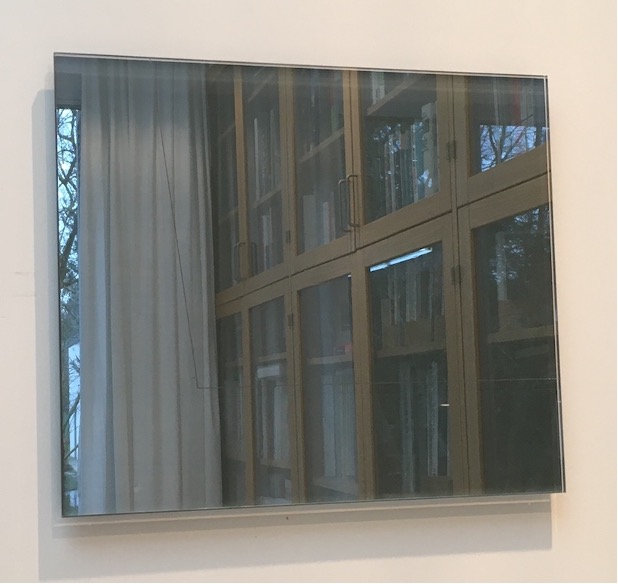
Edition Grauer Spiegel / Edition Grey Mirror
2021, Paint on glass, 40 x 34 x 1 cm, Ed. 179
|
Gerhard Richter applied monochrome gray paint to the reverse sides of a mirror. Instead of producing an image, Richter transforms the gray paint on glass into a ground for reflections. Viewers can see themselves and their surroundings mirrored on the dark surfaces, and one can interpret these monochromes as large-scale photographic plates of endless exposure. Blurring the boundary between painting and photography, the artist explores the complex relationship between abstraction and representation. Although Richter is, in many respects, a very traditional painter, and revels in all the things paint can do – render images of reality, create luscious concoctions of colour – he also has a strong cerebral, radical element to his make-up. Although still concerned with looking through a rectangular, window-like frame – much as his figurative or abstract paintings – Richter’s panes of glass and mirrors, that he has continued to make from 1967 to today, have affinities with Conceptual Art, and even with Marcel Duchamp’s Dada works. This mirror, colored grey by the pigment attached to the back of the glass, resembles Richter’s earlier ‘black and white’, photographic paintings, since the reality one sees reflected in its surface is grey, but also his monochrome grey canvases of the early 1970s.
|
Gerhard Richter (born in Dresden in 1932) is a German painter known for his diverse painting styles and subjects. His deliberate lack of commitment to a single stylistic direction has often been read as an attack on the implicit ideologies embedded in the specific histories of painting. Such distaste for aesthetic dogma has been interpreted as a response to his early art training in communist East Germany. Relying on scenes from newspapers, personal photographs, and magazines, Richter painted the victims of serial killers, portraits of famous European intellectuals, and German terrorists (the Red Army Faction, better known as the Baader-Meinhof Gang), among other media images. He also created a series of colour-chart paintings, which were the inspiration for his 2007 large stained glass window for Cologne Cathedral. Richter later returned to stained glass design when in 2020 he produced three sets of windows, which recall his scraped oil paintings, for Tholey Abbey, Germany’s oldest monastery. Richter was the recipient of many awards, among them the Golden Lion for painting at the 47th Venice Biennale (1997) and the Japan Art Association’s Praemium Imperiale prize for painting (1997). |
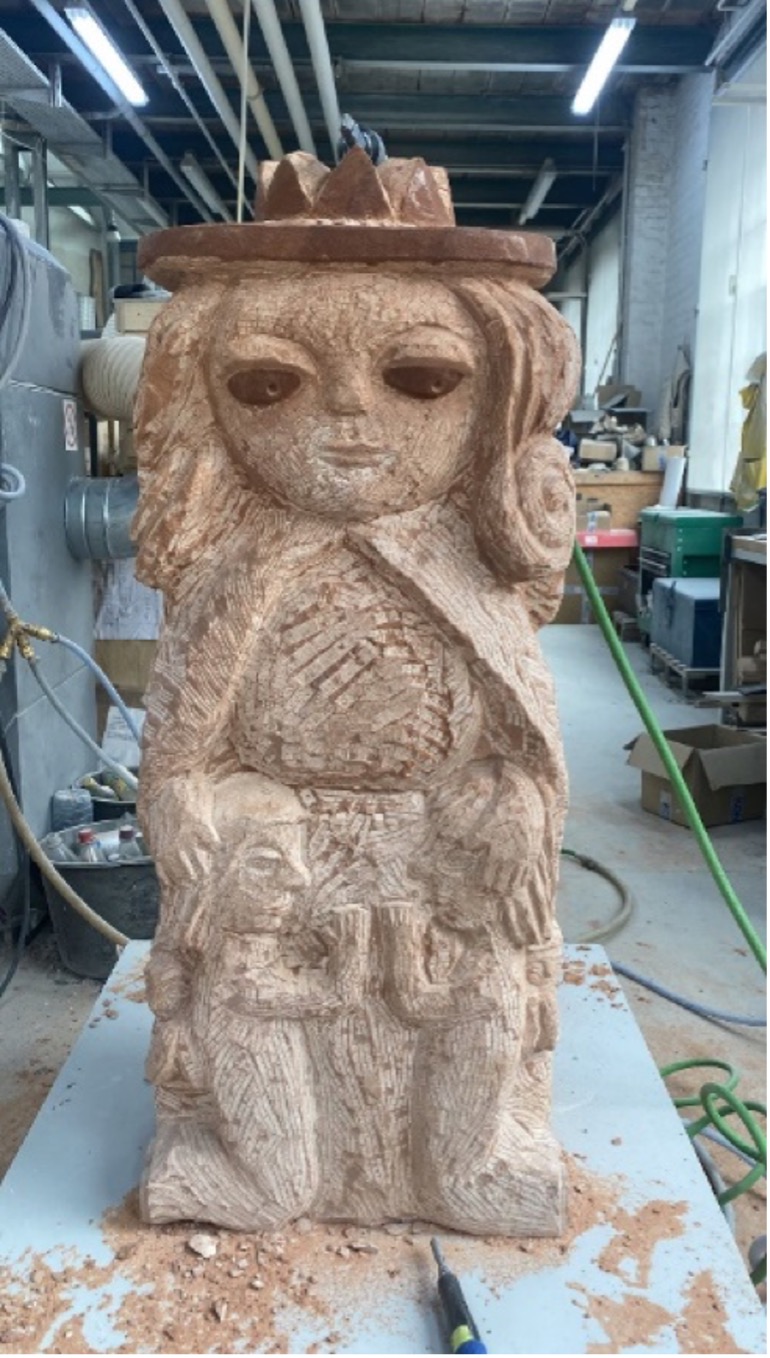
Schutzmantelmadonna / Madonna with Protective Mantle
2022, Sandstone, 110 x 40 x 30 cm
|
Stefan Rinck’s Madonna, created especially for POINTS of RESISTANCE IV: Skills for Peace, is a touching beacon of hope in troubled times. The two figures kneeling in a gesture of prayer beneath the protective embrace of her cloak resonate with us all, hoping and rayer for peace.
|
Stefan Rinck (born in 1973 in Homburg/Saar) is a German visual artist. He lives and works in Berlin. Rinck studied Art History and Philosophy at the Universität des Saarlandes in Saarbrücken and Sculpture at the Academy of Arts in Karlsruhe. He has had several gallery and museum exhibitions, including Museum de Hallen, Harlem (NL), Sorry We’re Closed, Brussels (BE), Nino Mier Gallery, Los Angeles (US), Vilma Gold, London (GB), Semiose, Paris (FR), Gallery Rüdiger Schöttle, Munich (DE), The Breeder, Athens (GR), Galeria Alegria, Madrid/Barcelona (ES) and Cruise&Callas, Berlin (DE). He participated at the Busan Biennale in South Korea and at the Vent des Fôret and La Forêt d’Art Contemporain in France where he realized permanent public sculptures. In 2018, the work The Mangooses of Beauvais was permanently installed in the city of Paris at 53-57 rue de Grennelle (Beaupassage). He is in the following public collections: CBK Rotterdam (NL), Musée de la Loterie (BE), Sammlung Krohne (DE), FRAC Corse (FR). In 2019, Stefan Rinck was featured in the Thames & Hudson publication 100 Sculptors of Tomorrow. The documentary Heart of Stone by Sonja Baeger, premiered in 2021 in Berlin, features Rinck’s production process of three monumental sculptures. |
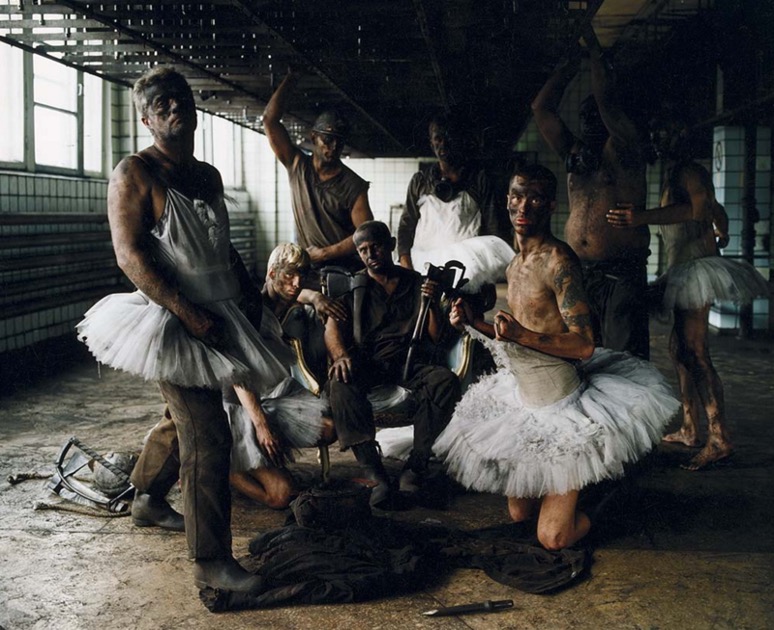
Donbass Chocolate
1997, C-print on Aluminum, 115 x 150 cm
|
Arsen Savadov first came to public attention in the mid-1990s when he published a series of fashion shoots of scantily clad models taken in cemeteries during funerals, with burials as the backdrop. The shocking and provocative juxtaposition of life and death, happiness and sorrow, power and weakness, transformed into an allegory of pretense and reality, has continued in his works until the present. During the 1990s, when the newly formed Republic of Ukraine was restructuring its economy, Savadov moved to work in obsolete industrial plants, initially in the coal fields of Donbass. His Donbass-Chocolate (1997) series of large photographs were made around Donetsk, a Soviet-era paragon of heavy industrial labor. Here, in close and camp detail, he depicted the semi-naked, still coal-dust-caked bodies of former miners. Once the Stakhanovite hero-workers of the Soviet Union, they are now garbed, ludicrously and pathetically by wispy fronds of ballerinas’ tutus. Initially referring to the false heroism of Soviet Labor, as well as to the lost souls of the newly unemployed masses, these works have, since the onset of the Russo-Ukrainian War in February 2014, moved away from sarcastic nostalgia to establish a more contemporary resonance with the pseudo-macho Russian-backed mercenaries who have occupied this territory and have provoked the current war.
|
Arsen Savadov (born in Kiev in 1962) is a noted Ukrainian conceptual photographer and painter, based between Kiev and New York City. He studied painting at the Shevchenko State Art School. Savadov graduated from the Kiev Art Institute in 1986 and was one of the first artists in Ukraine to work with video in the 1990s. A versatile artist during the course of his career, Savadov has utilized techniques of installation, performance, and photography. His solo exhibitions include Gulliver’s dream, Art Ukraine Gallery, Kiev (2017); First-person, Pecherskiy Gallery (V-art gallery), Moscow (2012); Paintings,Daniyal Mahmood Gallery New York (2007), Donbass-Chocolate, Galerie Orel Art Presenta, Paris (2003); Arsen Savadov, Chasie Post Gallery, Atlanta, USA (1995). Group shows include Art Riot: Post-Soviet Actionism, Saatchi Gallery, London (2017); Recycling Religion, WhiteBox, New York (2016); BALAGAN!!! Contemporary Art from the Former Soviet Union and Other Mythical Places, curated by David Elliott, MOMENTUM, Berlin (2015); Escape to Egypt, Collection Gallery, Kyiv (2012) and First-person, Pecherskiy Gallery, V-art gallery, Moscow (2012) as well as in group shows: Days of Ukraine in the United Kingdom, Saatchi Gallery, London (2013), the 1st Kyiv International Biennale of Contemporary Art (2012) and After the Wall. Art and Culture in post-Communist Europe, Stockholm, Budapest, Berlin, (1999/2000). |
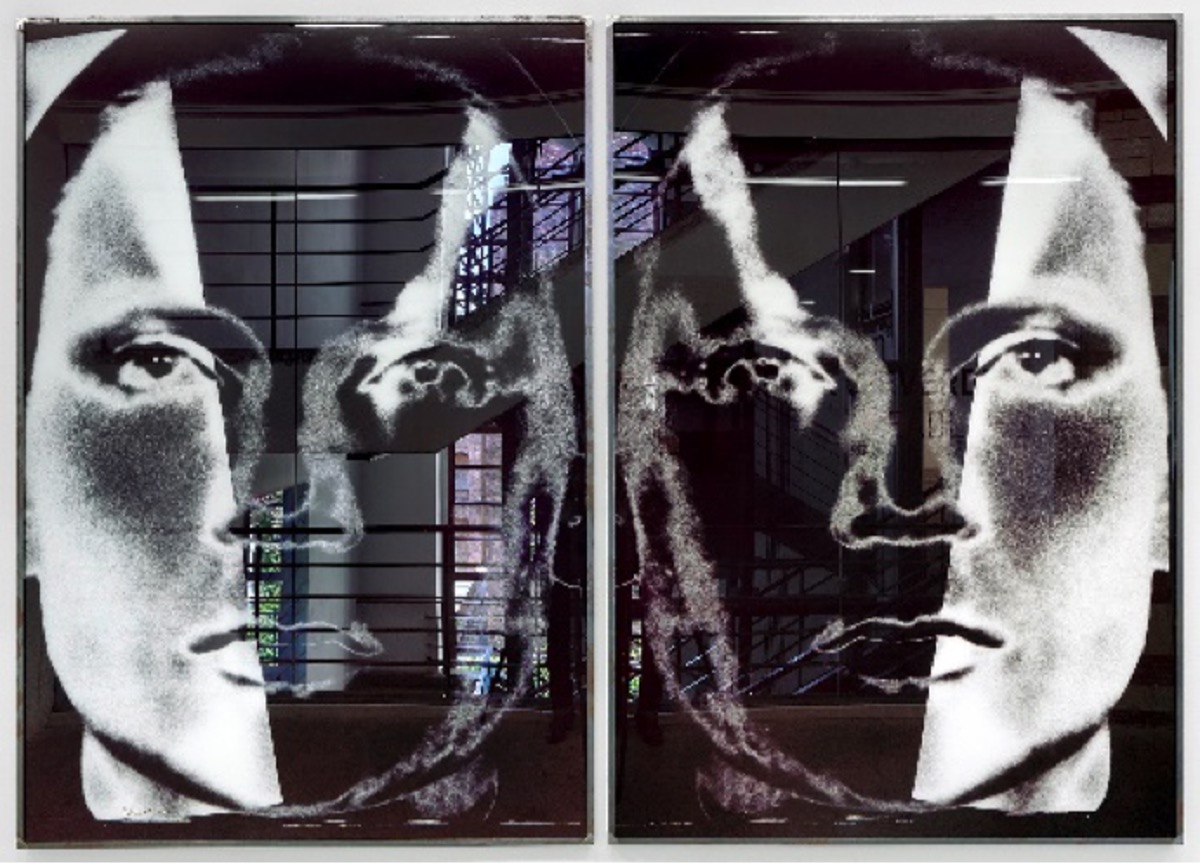
MATON SOLARISATION F-XI
1969/2022, Color photography, digital print, 300 x 150 cm, Unique work
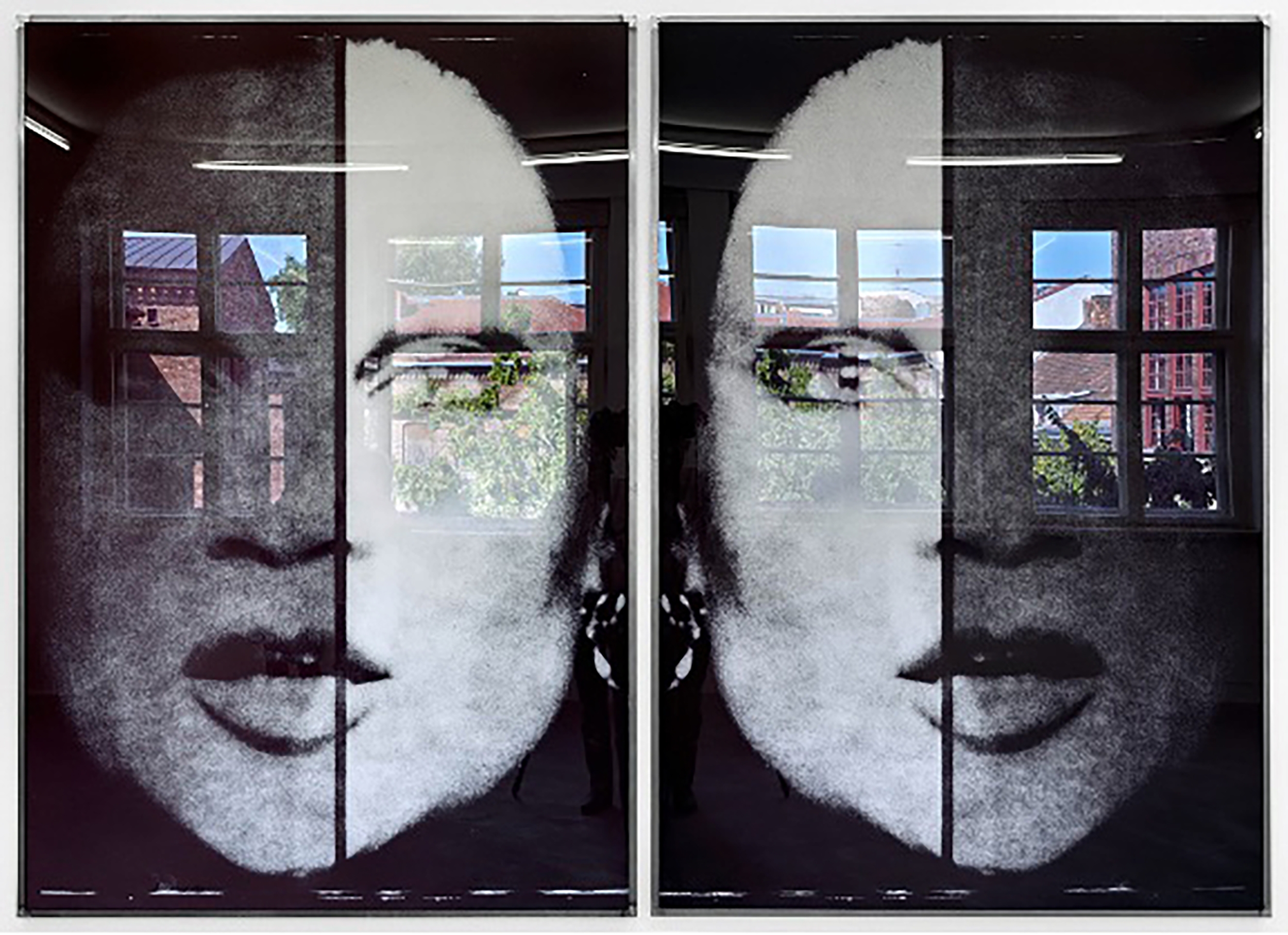
MATON SOLARISATION F-XII
1969/2022, Color photography, digital print, 300 x 150 cm
|
|
Katharina Sieverding (born in 1944) is a German photographer. Sieverding lives and works in Berlin and Düsseldorf. Sieverding’s works mostly consist of self-portraiture and most have an abstract quality. She uses the techniques of silhouette, contrast, and extreme close-up. Her work often makes statements about society and the individual, such as showing the familiarity of the self and the distance of others. Often she puts multiple portraits together in one piece. Each portrait fills the frame in a way to show the presence of self. Sieverding took part in documenta 5 in 1972, documenta 6 in 1977 and documenta 7 in 1982, Kassel, and in 1997 she exhibited in the German pavilion at the Venice Biennale. Her solo exhibitions include: Deutsche Guggenheim, Berlin (1998); Stedelijk Museum, Amsterdam (1998); Kunstsammlung NRW, Düsseldorf (1997–98); Kunst-Werke Institute for Contemporary Art, Berlin (1993); Neue Nationalgalerie, Berlin (1992). Collective exhibition: “Objectivités – La photographie à Düsseldorf” – Musée d’Art Moderne de la Ville de Paris (2008) C Les Rencontres d’Arles, France (2010). In the United States, her works have been shown at Solomon R. Guggenheim Museum, New York; Andy Warhol Museum, Pittsburgh; Dallas Museum of Art, Dallas; Walker Art Center, Minneapolis; and ICA, Boston. In 2004 and 2005, New York’s MoMA PS1 and Kunst-Werke Berlin presented an extensive survey of her work. She is a professor emeritus at the University of the Arts, Berlin. |
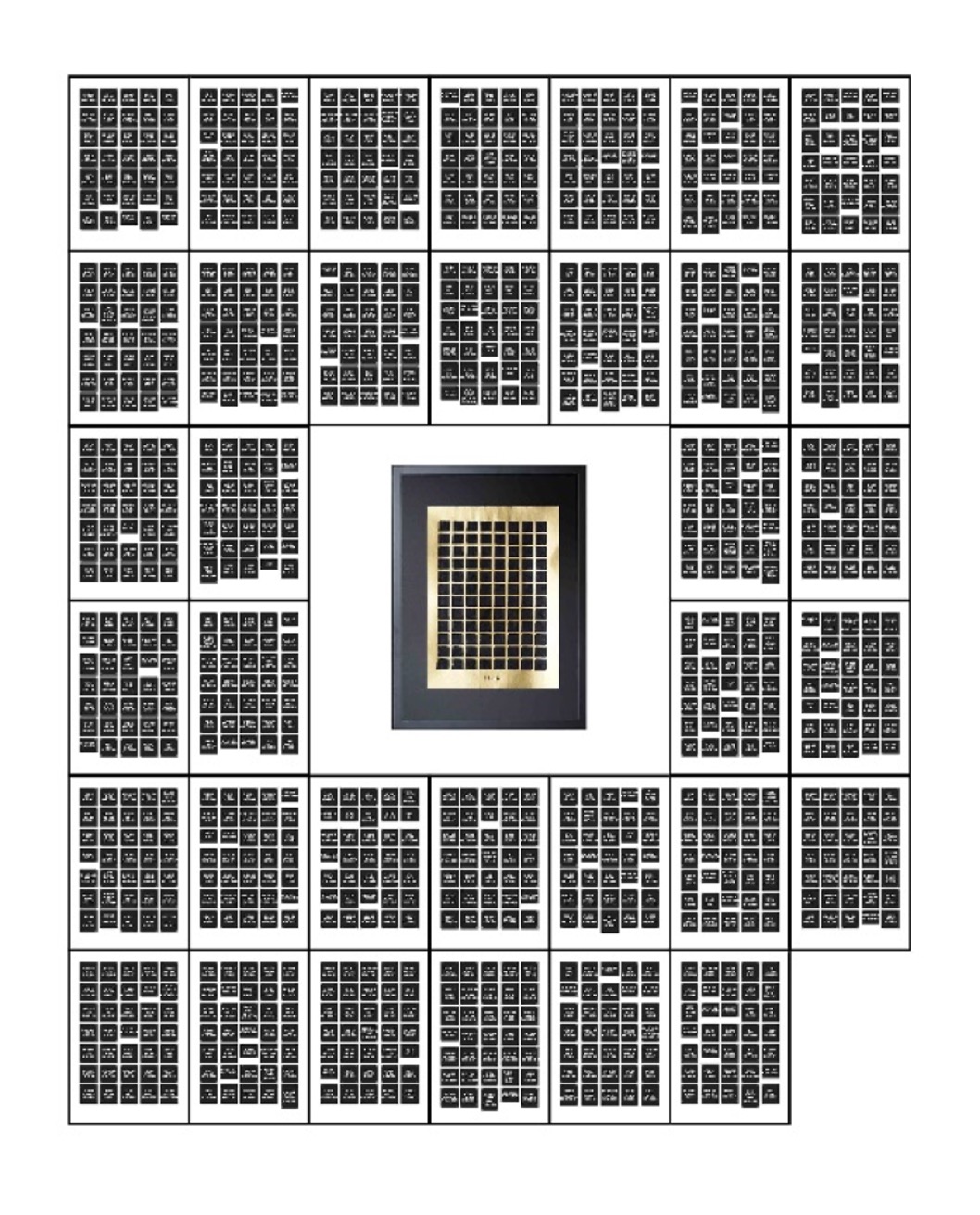
1000 Stalinistische Opfer auf einer Seite / 1000 Stalinist Victims on One Page
2021, Installation 36 x A4 sheets + 1 framed gold leaf print on paper, 150 x 180 cm, Ed. 1/4
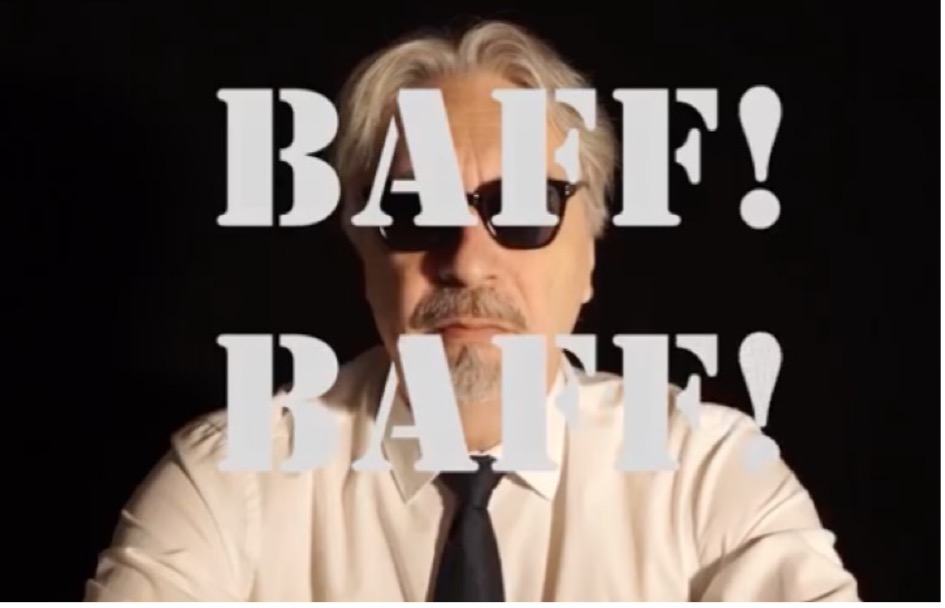
BAFF BAFF! What Are The Politicians Talking About / BAFF BAFF! Worüber sprechen die Politiker
2021, Video Performance, HD, sound, 4’20” exhibition variant (Original 65’), Ed. 1/4 – Original version 65’
|
Artist Statement for 1000 Stalinistische Opfer auf einer Seite: On one page are printed 1,000 portraits (one on top of the other) of Stalin’s victims. Around it are 1,000 names of these people. The work is based on materials collected by “Immortal Barracks”. Thank you to everyone who is trying to restore the memory of people who innocently suffered during Stalinist repressions. This memory is more important than ever today, at a time when Russia bombs Ukrainian homes and kills Ukrainian women and children… Consciously amnesia is a crime! (The proceeds from this work, in case of sale, will be transferred to the “Immortal Barracks” and will help the people of Ukraine.)
Artist Statement for BAFF BAFF! What Are The Politicians Talking About: “In the film, more than 1000 non-verbal words are read aloud, most of which have been found in the magazines “Mickey Mouse” (German editions) and also taken from the books “Tintin The Mysterious Star” and “Asterix & Obelix The Laurels of Caesar”. The words collected in the non-verbal vocabulary have no meaning, but only phonetically reflect certain events: someone has fainted (BLIEP!), a glass has broken (CRACK! CLIRR!), a helicopter has crashed into a cupola (KAROMMS!), a museum has collapsed (CRACK! THUNDER! CRIME!). The Reader (Vadim Zakharov), wearing a white shirt and a tie, recites these words seriously and forcefully. The image of a politician is created, a public figure who professionally and convincingly is ready to say something on any occasion. At the same time, we see that these are just empty words – bubbles that float away as soon as they reach our ears. The film highlights the absurdity of what we see and hear every day on television and the internet. At the same time, reading non-verbal words can be perceived as reading poetry… “ Vadim Zakharov’s works shown in POINTS of RESISTANCE IV: Skills for Peace present an all too fitting commentary on our current state of affairs where politicians spout nonsense at one another while remaining unable to stop the atrocities of war. BAFF BAFF! What Are The Politicians Talking About invokes the talking heads we see on news programs every day, recounting an equally incomprehensible reality which would be surreal were it not so tragic. While the 1000 Stalinist Victims are no longer a relic of a repressive history, but harbingers of what is to come – with the Russian regime resorting once again to the repression of all those opposed to its regressive policies, turning back to a time when the power of the state was wielded through ubiquitous terror and control. Stalinism may have changed names for a new millennium, but its tactics remain the same and its victims grow by the day.
|
Vadim Zakharov (born in UdSSR in 1959) is an artist, editor, archivist of the Moscow Conceptual art scene, and collector, living and working in Berlin. Since 1979 he has participated in exhibitions of unofficial art and collaborated with such artists as: V. Skersis, S. Anufriev, I. Chuikov, A. Monastyrski, Y. Leiderman. In 1982–1983 he participated in the AptArt Gallery, Moscow. Since 1992-2001 he has published the “Pastor” magazine and founded the Pastor Zond Edition. In 2006 he edited book “Moscow Conceptualism”. His retrospective was held at the Tretyakov Gallery in 2006, and he has exhibited at Guggenheim Museum, New York (2005), Guggenheim Museum Bilbao (2005), State Historical Museum Moscow (2003), amongst many others. Zalharov represented Russia at the Venice Biennale in 2013 with the project “DANAE”. In 2016-2020 Zakharov organized the exhibition space “FREEHOME-Artist to Artist” in Berlin. Selected honors and awards include: Griffelkunst-Preis, Hamburg (1995); Renta-Preis, Kunsthalle Nürnberg (1995); Soratnik Prize, Moscow (2006); Innovation Prize, Moscow (2006); Joseph Brodsky Memorial Fellowship Fund, American Academy in Rome (2007); Kandinsky Prize – Best Work of Year, Moscow (2009). |

